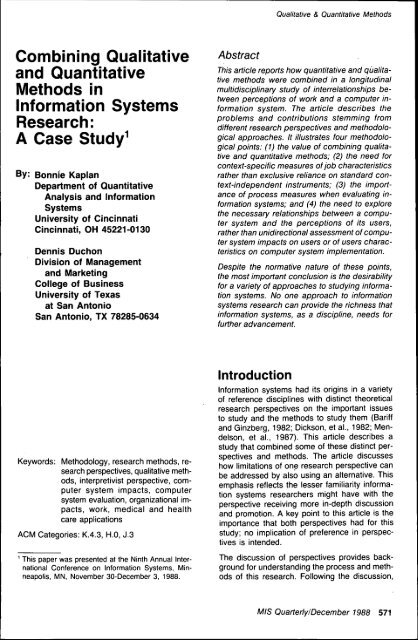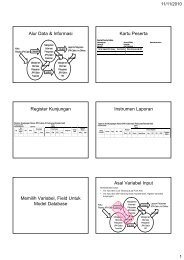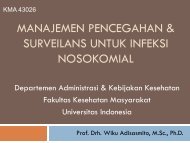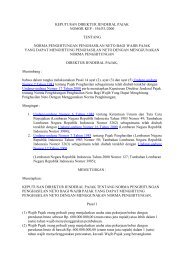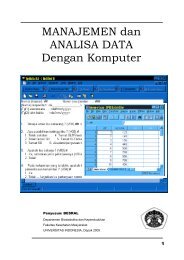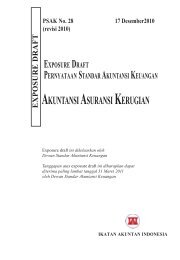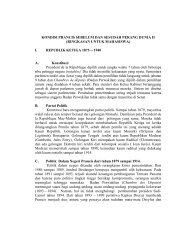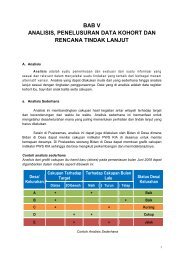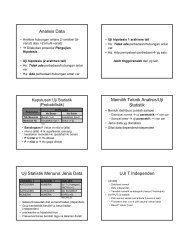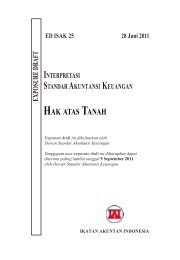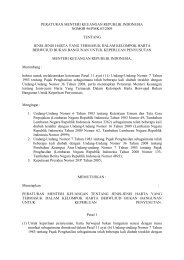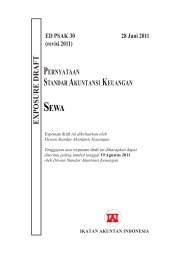Combining Qualitative and Quantitative Methods in ... - Blog Staff UI
Combining Qualitative and Quantitative Methods in ... - Blog Staff UI
Combining Qualitative and Quantitative Methods in ... - Blog Staff UI
Create successful ePaper yourself
Turn your PDF publications into a flip-book with our unique Google optimized e-Paper software.
<strong>Qualitative</strong> & <strong>Quantitative</strong> <strong>Methods</strong><br />
<strong>Comb<strong>in</strong><strong>in</strong>g</strong> <strong>Qualitative</strong><br />
<strong>and</strong> <strong>Quantitative</strong><br />
<strong>Methods</strong> <strong>in</strong><br />
Information Systems<br />
Research:<br />
A Case Study^<br />
By: Bonnie Kaplan<br />
Department of <strong>Quantitative</strong><br />
Anaiysis <strong>and</strong> <strong>in</strong>formation<br />
Systems<br />
University of C<strong>in</strong>c<strong>in</strong>nati<br />
C<strong>in</strong>c<strong>in</strong>nati, OH 45221-0130<br />
Dennis Duchon<br />
Division of iVIanagement<br />
<strong>and</strong> Maritet<strong>in</strong>g<br />
Coiiege of Bus<strong>in</strong>ess<br />
University of Texas<br />
at San Antonio<br />
San Antonio, TX 78285-0634<br />
Abstract<br />
This article reports how quantitative <strong>and</strong> quaiitative<br />
methods were comb<strong>in</strong>ed <strong>in</strong> a longitud<strong>in</strong>al<br />
multidiscipl<strong>in</strong>ary study of <strong>in</strong>terreiationships between<br />
perceptions of work <strong>and</strong> a computer <strong>in</strong>formation<br />
system. The articie describes the<br />
problems <strong>and</strong> contributions stemm<strong>in</strong>g from<br />
different research perspectives <strong>and</strong> methodological<br />
approaches. It illustrates four methodological<br />
po<strong>in</strong>ts: (1) the value of comb<strong>in</strong><strong>in</strong>g quaiitative<br />
<strong>and</strong> quantitative methods; (2) the need for<br />
context-specific measures of job characteristics<br />
rather than exciusive reliance on st<strong>and</strong>ard context-<strong>in</strong>dependent<br />
<strong>in</strong>struments; (3) the importance<br />
of process measures when evaluat<strong>in</strong>g <strong>in</strong>formation<br />
systems; <strong>and</strong> (4) the need to explore<br />
the necessary relationships between a computer<br />
system <strong>and</strong> the perceptions of its users,<br />
rather than unidirectional assessment of computer<br />
system impacts on users or of users characteristics<br />
on computer system impiementation.<br />
Despite the normative nature of these po<strong>in</strong>ts,<br />
the most important conclusion is the desirability<br />
for a variety of approaches to study<strong>in</strong>g <strong>in</strong>formation<br />
systems. No one approach to <strong>in</strong>formation<br />
systems research can provide the richness that<br />
<strong>in</strong>formation systems, as a discipl<strong>in</strong>e, needs for<br />
further advancement.<br />
Keywords: Methodology, research methods, research<br />
perspectives, qualitative methods,<br />
<strong>in</strong>terpretivist perspective, computer<br />
system impacts, computer<br />
system evaluation, organizational impacts,<br />
work, medical <strong>and</strong> health<br />
care applications<br />
ACM Categories: K,4,3, H.O, J,3<br />
' This paper was presented at the N<strong>in</strong>th Annual International<br />
Conference on Information Systems, M<strong>in</strong>neapolis,<br />
MN, November 30-December 3, 1988,<br />
Introduction<br />
Information systems had its orig<strong>in</strong>s <strong>in</strong> a variety<br />
of reference discipl<strong>in</strong>es with dist<strong>in</strong>ct theoretical<br />
research perspectives on the important issues<br />
to study <strong>and</strong> the methods to study them (Bariff<br />
<strong>and</strong> G<strong>in</strong>zberg, 1982; Dickson, et al., 1982; Mendelson,<br />
et al,, 1987), This article describes a<br />
study that comb<strong>in</strong>ed some of these dist<strong>in</strong>ct perspectives<br />
<strong>and</strong> methods. The article discusses<br />
how limitations of one research perspective can<br />
be addressed by also us<strong>in</strong>g an alternative. This<br />
emphasis reflects the lesser familiarity <strong>in</strong>formation<br />
systems researchers might have with the<br />
perspective receiv<strong>in</strong>g more <strong>in</strong>-depth discussion<br />
<strong>and</strong> promotion, A key po<strong>in</strong>t to this article is the<br />
importance that both perspectives had for this<br />
study; no implication of preference <strong>in</strong> perspectives<br />
is <strong>in</strong>tended.<br />
The discussion of perspectives provides background<br />
for underst<strong>and</strong><strong>in</strong>g the process <strong>and</strong> methods<br />
of this research. Follow<strong>in</strong>g the discussion.<br />
MIS Quarterly/December 1988 571
Quaiitative & <strong>Quantitative</strong> <strong>Methods</strong><br />
the article describes how this study evolved. The<br />
emphasis is on methods rather than on research<br />
f<strong>in</strong>d<strong>in</strong>gs.<br />
The positivist perspective <strong>and</strong><br />
quantitative methods<br />
Despite the differences <strong>in</strong> reference discipl<strong>in</strong>es<br />
<strong>and</strong> the debate over a paradigm for <strong>in</strong>formation<br />
systems, American <strong>in</strong>formation systems research<br />
generally is characterized by a methodology of<br />
formulat<strong>in</strong>g hypotheses that are tested through<br />
controlled experiment or statistical analysis. The<br />
assumption underly<strong>in</strong>g this methodological approach<br />
is that research designs should be based<br />
on the positivist model of controll<strong>in</strong>g (or at least<br />
measur<strong>in</strong>g) variables <strong>and</strong> test<strong>in</strong>g pre-specified<br />
hypotheses (Kauber, 1986), although alternative<br />
methods might be acceptable until research has<br />
reached this more advanced <strong>and</strong> "scientific"<br />
stage. Despite some recent recognition given different<br />
research perspectives <strong>and</strong> methods (e.g,,<br />
Ives <strong>and</strong> Olson, 1984; Kle<strong>in</strong>, 1986; Kl<strong>in</strong>g, 1980;<br />
Lyyt<strong>in</strong>en, 1987; Markus <strong>and</strong> Robey, 1988;<br />
Weick, 1984), even those who argue for <strong>in</strong>troduc<strong>in</strong>g<br />
doctoral students to such alternative approaches<br />
as field study <strong>and</strong> simulation methods<br />
nevertheless advocate research based primarily<br />
on the positivist tradition (e.g,, Bariff <strong>and</strong><br />
G<strong>in</strong>zberg, 1982; Dickson, et al,, 1982),<br />
Exclusive reliance on statistical or experimental<br />
test<strong>in</strong>g of hypotheses has been soundly criticized<br />
<strong>in</strong> the social sciences, where some of its major<br />
proponents have called its effects "disastrous"<br />
(Cook <strong>and</strong> Campbell, 1979, p, 92), There are<br />
two grounds on which the approach can be<br />
faulted. First, the assumption that only through<br />
statistical or experimental hypothesis test<strong>in</strong>g will<br />
science progress has come under attack, particularly<br />
by psychologists who perhaps have the<br />
dubious dist<strong>in</strong>ction of hav<strong>in</strong>g practiced it the longest,<br />
Meehl (1978), for example, argues that science<br />
does not, <strong>and</strong> cannot, proceed by <strong>in</strong>cremental<br />
ga<strong>in</strong>s achieved through statistical significance<br />
test<strong>in</strong>g of hypotheses. Sociologists, too,<br />
have contributed to this debate, notably with<br />
Glaser <strong>and</strong> Strauss' (1967) <strong>in</strong>fluential argument<br />
for theory build<strong>in</strong>g through <strong>in</strong>ductive qualitative<br />
research rather than through cont<strong>in</strong>ual hypothesis<br />
test<strong>in</strong>g.<br />
A second fault with the approach is the reliance<br />
on experimental or statistical control as the def<strong>in</strong><strong>in</strong>g<br />
feature of scientific research. This reliance<br />
stems from the admirable goal of controll<strong>in</strong>g experimenter<br />
bias by striv<strong>in</strong>g for objective measures<br />
of phenomena. Achiev<strong>in</strong>g this goal has<br />
been assumed to require the use of quantifiable<br />
data <strong>and</strong> statistical analysis (Downey <strong>and</strong> Irel<strong>and</strong>,<br />
1983; Kauber, 1986) <strong>and</strong> also remov<strong>in</strong>g<br />
the effects of context <strong>in</strong> order to produce generalizable,<br />
reproducible results.<br />
However, because the study of social systems<br />
<strong>in</strong>volves so many uncontrolled — <strong>and</strong> unidentified<br />
— variables, methods for study<strong>in</strong>g closed<br />
systems do not apply as well <strong>in</strong> natural sett<strong>in</strong>gs<br />
as <strong>in</strong> controlled ones (Cook <strong>and</strong> Campbell, 1979;<br />
Manicas <strong>and</strong> Secord, 1983; Maxwell, et al,,<br />
1986), Moreover, the simplification <strong>and</strong> abstraction<br />
needed for good experimental design can<br />
remove enough features from the subject of<br />
study that only obvious results are possible. As<br />
illustrated <strong>in</strong> the next section, the stripp<strong>in</strong>g of<br />
context buys "objectivity" <strong>and</strong> testability at the<br />
cost of a deeper underst<strong>and</strong><strong>in</strong>g of what actually<br />
is occurr<strong>in</strong>g,^<br />
The <strong>in</strong>terpretive perspective <strong>and</strong><br />
quantitative methods<br />
The need for context-dependent research has<br />
been remarked upon by researchers <strong>in</strong> a variety<br />
of discipl<strong>in</strong>es that, like <strong>in</strong>formation systems, necessarily<br />
<strong>in</strong>corporate field research methods.<br />
Even such strong advocates of quantitative <strong>and</strong><br />
experimental approaches <strong>in</strong> behavioral research<br />
as Cook <strong>and</strong> Campbell (1979) state, "Field experimentation<br />
should always <strong>in</strong>clude qualitative<br />
research to describe <strong>and</strong> illum<strong>in</strong>ate the context<br />
<strong>and</strong> conditions under which research is conducted"<br />
(p, 93),<br />
Immersion <strong>in</strong> context is a hallmark of qualitative<br />
research methods <strong>and</strong> the <strong>in</strong>terpretive perspective<br />
on the conduct of research. Interpretive researchers<br />
attempt to underst<strong>and</strong> the way others<br />
construe, conceptualize, <strong>and</strong> underst<strong>and</strong> events,<br />
concepts, <strong>and</strong> categories, <strong>in</strong> part because these<br />
are assumed to <strong>in</strong>fluence <strong>in</strong>dividuals behavior.<br />
The researchers exam<strong>in</strong>e the social reality <strong>and</strong><br />
<strong>in</strong>tersubjective mean<strong>in</strong>gs held by subjects (Bredo<br />
<strong>and</strong> Fe<strong>in</strong>berg, 1982a) by elicit<strong>in</strong>g <strong>and</strong> observ<strong>in</strong>g<br />
what is significant <strong>and</strong> important to the subjects<br />
<strong>in</strong> situations where the behavior occurs ord<strong>in</strong>arily.<br />
Consequently, qualitative methods are characterized<br />
by (1) the detailed observation of, <strong>and</strong><br />
^ We would like to credit an anonymous reviewer with<br />
this po<strong>in</strong>t.<br />
572 MIS Quarterly/December 1988
<strong>Qualitative</strong> & <strong>Quantitative</strong> <strong>Methods</strong><br />
<strong>in</strong>volvement of the researcher <strong>in</strong>, the natural sett<strong>in</strong>g<br />
<strong>in</strong> which the study occurs, <strong>and</strong> (2) the attempt<br />
to avoid prior commitment to theoretical<br />
constructs or to hypotheses formulated before<br />
gather<strong>in</strong>g any data (Y<strong>in</strong>, 1984),<br />
<strong>Qualitative</strong> strategies emphasize an <strong>in</strong>terpretive<br />
approach that uses data to both pose <strong>and</strong> resolve<br />
research questions. Researchers develop<br />
categories <strong>and</strong> mean<strong>in</strong>gs from the data through<br />
an iterative process that starts by develop<strong>in</strong>g an<br />
<strong>in</strong>itial underst<strong>and</strong><strong>in</strong>g of the perspectives of those<br />
be<strong>in</strong>g studied. That underst<strong>and</strong><strong>in</strong>g is then tested<br />
<strong>and</strong> modified through cycles of additional data<br />
collection <strong>and</strong> analysis until coherent <strong>in</strong>terpretation<br />
is reached (Bredo <strong>and</strong> Fe<strong>in</strong>berg, 1982a; Van<br />
Maanen, 1983b), Thus, although qualitative methods<br />
provide less explanation of variance <strong>in</strong> statistical<br />
terms than quantitative methods, they can<br />
yield data from which process theories <strong>and</strong> richer<br />
explanations of how <strong>and</strong> why processes <strong>and</strong> outcomes<br />
occur can be developed (Marcus <strong>and</strong><br />
Robey, 1988),<br />
Research traditions <strong>in</strong> <strong>in</strong>formation<br />
systems<br />
The grow<strong>in</strong>g recognition of the value of qualitative<br />
methods <strong>in</strong> social, behavioral, organizational,<br />
<strong>and</strong> evaluation research is manifest <strong>in</strong> studies<br />
<strong>and</strong> research methodology texts (Argyris, 1985;<br />
Bredo <strong>and</strong> Fe<strong>in</strong>berg, 1982b; L<strong>in</strong>coln <strong>and</strong> Guba,<br />
1985; Miles <strong>and</strong> Huberman, 1984; M<strong>in</strong>tzberg,<br />
1973; Patton, 1978; Van Maanen, 1983c), Van<br />
Maanen (1983a), for example, has long advanced<br />
<strong>and</strong> practiced these approaches <strong>in</strong> organizational<br />
research. However, despite the<br />
strong ties of <strong>in</strong>formation systems with organizational<br />
<strong>and</strong> behavioral research, the use of qualitative<br />
research, though practiced <strong>and</strong> advocated<br />
<strong>in</strong> <strong>in</strong>formation systems, has not been as visible<br />
<strong>in</strong> this field as <strong>in</strong> others. Instead, recently there<br />
has been greater reliance on laboratory studies<br />
<strong>and</strong> surveys (Goldste<strong>in</strong>, et al,, 1986),<br />
The dom<strong>in</strong>ant approach to <strong>in</strong>formation technology<br />
studies has been based on a positivistic experimental<br />
ideal of research. Us<strong>in</strong>g this approach,<br />
researchers exam<strong>in</strong>e the effects of one<br />
or more variables on another. These analyses<br />
tend to treat the research objects <strong>in</strong> one of two<br />
ways. Either they portray <strong>in</strong>formation technology<br />
as the determ<strong>in</strong><strong>in</strong>g factor <strong>and</strong> users as passive,<br />
or they view users or organizations as act<strong>in</strong>g<br />
<strong>in</strong> rational consort to achieve particular outcomes<br />
through the use of <strong>in</strong>formation technology. In<br />
either case, the nature of the <strong>in</strong>formation technology<br />
<strong>and</strong> users is considered static <strong>in</strong> that they<br />
are assumed to have an essential character that<br />
is treated as unchang<strong>in</strong>g over the course of the<br />
study (Bakos, 1987; Lyyt<strong>in</strong>en, 1987),<br />
Markus <strong>and</strong> Robey (1988) characterize such approaches<br />
as "variance theory formulations of logical<br />
structure <strong>and</strong> an imperative conception of<br />
causal agency," In variance theories, some elements<br />
are identified as antecedents, <strong>and</strong> these<br />
are conceived as necessary <strong>and</strong> sufficient conditions<br />
for the elements identified as outcomes<br />
to occur. Accord<strong>in</strong>g to Markus <strong>and</strong> Robey, much<br />
of the th<strong>in</strong>k<strong>in</strong>g about the consequences of <strong>in</strong>formation<br />
technology <strong>in</strong> organizations assumes that<br />
either technology ("the technological imperative")<br />
or human be<strong>in</strong>gs ("the organizational imperative")<br />
are the antecedents, or agents, of change<br />
rather than that change emerges from complex<br />
<strong>in</strong>determ<strong>in</strong>ant <strong>in</strong>teractions between them ("the<br />
emergent perspective").<br />
Most studies of computer systems are based on<br />
methods that measure quantitative outcomes.<br />
These outcomes can be grouped <strong>in</strong>to technical,<br />
economic, <strong>and</strong> effectiveness <strong>and</strong> performance<br />
measures. Such studies treat organizational features,<br />
user features, technological features, <strong>and</strong><br />
<strong>in</strong>formation needs as static, <strong>in</strong>dependent, <strong>and</strong><br />
objective rather than as dynamic, <strong>in</strong>teract<strong>in</strong>g constructs,<br />
i,e,, as concepts with attributes <strong>and</strong> mean<strong>in</strong>gs<br />
that may change over time <strong>and</strong> that may<br />
be def<strong>in</strong>ed differently accord<strong>in</strong>g to how <strong>in</strong>dividual<br />
participants view <strong>and</strong> experience the relationships<br />
between them.<br />
Because such studies are restricted to readily<br />
measured static constructs, they neglect aspects<br />
of cultural environment, <strong>and</strong> social <strong>in</strong>teraction<br />
<strong>and</strong> negotiation that could affect not only the outcomes<br />
(Lyyt<strong>in</strong>en, 1987), but also the constructs<br />
under study. Indeed, most evaluations of computer<br />
<strong>in</strong>formation systems exhibit these characteristics.<br />
Published accounts of comput<strong>in</strong>g traditionally<br />
focus on selected technical <strong>and</strong> economic<br />
characteristics of the computer system<br />
that are assessed accord<strong>in</strong>g to what Kl<strong>in</strong>g <strong>and</strong><br />
Scacchi (1982) call the "discrete-entity model,"<br />
Economic, physical, or <strong>in</strong>formation process<strong>in</strong>g features<br />
are explicitly chosen for study under the<br />
assumption that the computer system can be<br />
broken down <strong>in</strong>to relatively <strong>in</strong>dependent elements<br />
of equipment, people, organizational processes,<br />
<strong>and</strong> the like. These elements can then<br />
be evaluated <strong>in</strong>dependently <strong>and</strong> additively.<br />
Social or political issues often are ignored.<br />
MIS Quarteriy/December 1988 573
<strong>Qualitative</strong> & <strong>Quantitative</strong> <strong>Methods</strong><br />
That these assumptions underlie much of the<br />
research on <strong>in</strong>formation technology is evident<br />
<strong>in</strong> the implementation <strong>and</strong> impacts literature. The<br />
effects of some <strong>in</strong>tervention are studied with respect<br />
to implementation success or impacts on,<br />
for example, organizational structure, user attitudes,<br />
or job satisfaction (Bakos, 1987; Danziger,<br />
1985; Ives <strong>and</strong> Olson, 1984; Kl<strong>in</strong>g, 1980; Markus<br />
<strong>and</strong> Robey, 1988), In these studies, <strong>in</strong>formation<br />
systems or computers are treated as hav<strong>in</strong>g "impacts"<br />
(Danziger, 1985) rather than as socially<br />
constructed concepts with mean<strong>in</strong>gs that are affected<br />
by the "impacts" <strong>and</strong> that change from<br />
person to person or over time. Few such impact<br />
studies are longitud<strong>in</strong>al — a design promoted<br />
<strong>in</strong> <strong>in</strong>formation systems research to track changes<br />
over time by collect<strong>in</strong>g data as events occur<br />
rather than retrospectively (Franz <strong>and</strong> Robey,<br />
1984; Vitalari, 1985),<br />
Often such studies do not proceed from an <strong>in</strong>teractionist<br />
framework — one that focuses on<br />
the <strong>in</strong>teraction between characteristics related to<br />
people or subunits affected by the computer<br />
system <strong>and</strong> characteristics related to the system<br />
itself (Markus <strong>and</strong> Robey, 1988). For example,<br />
they tend not to explore <strong>in</strong>terrelationships between<br />
job-related issues <strong>and</strong> effectiveness of <strong>in</strong>formation<br />
technology. Jobs are often considered<br />
fixed, even though there are empirical <strong>and</strong> theoretical<br />
reasons to expect that computers change<br />
the amount <strong>and</strong> nature of work performed by<br />
system users (Brooks, et al,, 1977; Fok, et al,,<br />
1987; Kemp <strong>and</strong> Clegg, 1987; Kl<strong>in</strong>g, 1980; Millman<br />
<strong>and</strong> Hartwick, 1987; Zuboff, 1982; 1988),<br />
Moreover, job-related issues are <strong>in</strong>terpreted differently<br />
by different <strong>in</strong>dividuals with<strong>in</strong> an organization,<br />
<strong>and</strong> these differences can affect what constitutes<br />
a technology's "effectiveness" (Kl<strong>in</strong>g, 1980;<br />
Lyyt<strong>in</strong>en, 1987), Goodhue (1986), for example,<br />
advises assess<strong>in</strong>g the "fit" of an <strong>in</strong>formation system<br />
with a task. However, one person perform<strong>in</strong>g<br />
the task may have a rather different view of it than<br />
another person perform<strong>in</strong>g ostensibly the same<br />
task, <strong>and</strong> thus the "fit" will differ for different users.<br />
Consequently, different <strong>in</strong>dividuals may have<br />
different responses to the same system, Interactionist<br />
theories would account for this response.<br />
Theories that assume that the <strong>in</strong>dividual, the job or,<br />
task, the organization, or the technology is fixed<br />
<strong>and</strong> that one of these determ<strong>in</strong>es outcomes would<br />
not (Markus <strong>and</strong> Robey, 1988),<br />
Some argue that each type of research method<br />
has its appropriate uses (Markus <strong>and</strong> Robey,<br />
1988; Rockart, 1984; Weick, 1984); different research<br />
perspectives focus on different research<br />
questions <strong>and</strong> analytical assumptions (Kl<strong>in</strong>g,<br />
1980; Kl<strong>in</strong>g <strong>and</strong> Scacchi, 1982; Lyyt<strong>in</strong>en, 1987;<br />
Markus, 1983; Markus <strong>and</strong> Robey, 1988), However,<br />
there is disagreement concern<strong>in</strong>g the value<br />
<strong>and</strong> use of suggested alternative theoretical perspectives<br />
<strong>and</strong> practical approaches, such as critical<br />
social theory (Kle<strong>in</strong>, 1986), structuration<br />
theory (Barley, 1986), case study (Benbasat, et<br />
al,, 1987), <strong>and</strong> socio-technical design (Fok, et<br />
al., 1987; Mumford <strong>and</strong> Henshall, 1979). On the<br />
one h<strong>and</strong>, Mumford (1985) advocates a qualitative<br />
approach. She calls for studies of a "total"<br />
situation through action-centered, <strong>in</strong>terdiscipl<strong>in</strong>ary,<br />
participatory research <strong>in</strong> which research<br />
questions <strong>and</strong> hypotheses evolve as new developments<br />
are <strong>in</strong>troduced, Lyyt<strong>in</strong>en (1987)<br />
makes a similar appeal for case studies <strong>and</strong> action<br />
research on the grounds that "this research<br />
strategy seems to be the only means of obta<strong>in</strong><strong>in</strong>g<br />
sufficiently rich data" <strong>and</strong> because the validity of<br />
such methods "is better than that of empirical<br />
studies," On the other h<strong>and</strong>, even some proponents<br />
of case study base their position on a research<br />
design that fits the quantitative or quasiexperimental<br />
approach rather than the qualitative<br />
one (Benbasat, et al,, 1987; Campbell, 1984; Y<strong>in</strong>,<br />
1984), Moveover, there has been strong sentiment<br />
that <strong>in</strong>formation systems researchers need<br />
to move beyond case study to more experimental<br />
laboratory or field tests (Benbasat, 1984),<br />
<strong>Comb<strong>in</strong><strong>in</strong>g</strong> <strong>Methods</strong><br />
Although not the dom<strong>in</strong>ant paradigm, qualitative<br />
methods <strong>and</strong> <strong>in</strong>terpretive perspectives have<br />
been used <strong>in</strong> a variety of ways <strong>in</strong> <strong>in</strong>formation<br />
systems research (Barley, 1986; Fok, et al,,<br />
1987; Franz <strong>and</strong> Robey, 1984; Goldste<strong>in</strong>, et al,,<br />
1986; Hirschheim, et al,, 1987; Markus, 1983;<br />
Mumford <strong>and</strong> Henshall, 1979; Mumford, et al.,<br />
1985), Interpret<strong>in</strong>g <strong>in</strong>formation technology <strong>in</strong><br />
terms of social action <strong>and</strong> mean<strong>in</strong>gs is becom<strong>in</strong>g<br />
more popular as evidence grows that <strong>in</strong>formation<br />
systems development <strong>and</strong> use is a social<br />
as well as technical process that <strong>in</strong>cludes problems<br />
related to social, organization, <strong>and</strong> conceptual<br />
aspects of the system (Bl<strong>and</strong>, 1978; Hirschheim,<br />
et al., 1987; Kl<strong>in</strong>g <strong>and</strong> Scacchi, 1982;<br />
Lyyt<strong>in</strong>en, 1987; Markus, 1983), However, many<br />
<strong>in</strong>formation systems researchers who recognize<br />
the value of qualitative methods often portray<br />
these methods either as st<strong>and</strong>-alone or as a<br />
means of exploratory research prelim<strong>in</strong>ary to the<br />
"real" research of generat<strong>in</strong>g hypotheses to be<br />
tested us<strong>in</strong>g experimental or statistical tech-<br />
574 MIS Quarterly/December 1988
<strong>Qualitative</strong> & <strong>Quantitative</strong> <strong>Methods</strong><br />
niques (Benbasat, 1984), Even papers <strong>in</strong> which<br />
qualitative <strong>and</strong> quantitative methods are comb<strong>in</strong>ed<br />
rarely report the study's methodological<br />
rationale or details (Benbasat, et al,, 1987), One<br />
result is the failure to discuss how qualitative<br />
methods can be comb<strong>in</strong>ed productively with quantitative<br />
ones.<br />
There has been a move <strong>in</strong> other fields toward<br />
comb<strong>in</strong><strong>in</strong>g qualitative <strong>and</strong> quantitative methods<br />
to provide a richer, contextual basis for <strong>in</strong>terpretat<strong>in</strong>g<br />
<strong>and</strong> validat<strong>in</strong>g results (Cook <strong>and</strong><br />
Reichardt, 1979; Light <strong>and</strong> Pillemer, 1982;<br />
Maxwell, 1986; Meyers, 1981; Van Maanen, et<br />
al,, 1982; 1983a), These methods need not be<br />
viewed as polar opposites (Van Maanen,<br />
1983b), It is possible to <strong>in</strong>tegrate quantitative <strong>and</strong><br />
qualitative methods (Maxwell, et al,, 1986), <strong>Comb<strong>in</strong><strong>in</strong>g</strong><br />
these methods <strong>in</strong>troduces both testability<br />
<strong>and</strong> context <strong>in</strong>to the research. Collect<strong>in</strong>g different<br />
k<strong>in</strong>ds of data by different methods from different<br />
sources provides a wider range of coverage<br />
that may result <strong>in</strong> a fuller picture of the unit<br />
under study than would have been achieved otherwise<br />
(Bonoma, 1985), Moreover, us<strong>in</strong>g multiple<br />
methods <strong>in</strong>creases the robustness of results<br />
because f<strong>in</strong>d<strong>in</strong>gs can be strengthened through<br />
triangulation — the cross-validation achieved<br />
when different k<strong>in</strong>ds <strong>and</strong> sources of data converge<br />
<strong>and</strong> are found congruent (Benbasat, et<br />
al,, 1987; Bonoma, 1985; Jick, 1983; Y<strong>in</strong>, 1984),<br />
or when an explanation is developed to account<br />
for all the data when they diverge (Trend, 1979),<br />
This article describes how qualitative <strong>and</strong> quantitative<br />
methods were comb<strong>in</strong>ed dur<strong>in</strong>g the first<br />
phase of an ongo<strong>in</strong>g multi-method longitud<strong>in</strong>al<br />
study. Detailed research results are reported elsewhere<br />
(Kaplan, 1986; 1987; Kaplan <strong>and</strong> Duchon,<br />
1987a; 1987b; 1987c) <strong>and</strong> summarized here. This<br />
article has a methodological focus. It describes the<br />
development <strong>and</strong> process of the research <strong>and</strong><br />
omits all but sketches of the data <strong>and</strong> analysis<br />
necessary to underst<strong>and</strong> how the research<br />
evolved. Particular attention is given to how both<br />
quantitative <strong>and</strong> qualitative methods were used<br />
productively <strong>in</strong> a collaboration among <strong>in</strong>vestigators<br />
from different research perspectives.<br />
Research Sett<strong>in</strong>g<br />
Organizational <strong>and</strong> <strong>in</strong>formation<br />
context<br />
Computers have been used more <strong>in</strong> cl<strong>in</strong>ical laboratories<br />
than <strong>in</strong> many other areas of medical practice<br />
(Paplanus, 1985), The cl<strong>in</strong>ical laboratory represents<br />
a microcosm of automation <strong>and</strong> <strong>in</strong>formation<br />
needs from throughout a medical center<br />
(L<strong>in</strong>coln <strong>and</strong> Korpman, 1980), The laboratory is<br />
responsible for perform<strong>in</strong>g tests ordered by physicians<br />
to diagnose illness or track the course<br />
of therapy <strong>and</strong> disease. Laboratories meet this<br />
responsibility by receiv<strong>in</strong>g <strong>and</strong> process<strong>in</strong>g physicians'<br />
test orders, i,e,, collect<strong>in</strong>g specimens<br />
(such as blood) from patients, perform<strong>in</strong>g the<br />
designated tests (such as blood sugar measurements<br />
or assessments of bacterial sensitivity<br />
to antibiotics), <strong>and</strong> report<strong>in</strong>g the test results for<br />
use by the physician <strong>and</strong> for <strong>in</strong>clusion <strong>in</strong> the patient's<br />
medical record. Laboratory technologists,<br />
who are specially tra<strong>in</strong>ed, perform the laboratory<br />
tests. They may also report the results <strong>and</strong><br />
discuss them with those treat<strong>in</strong>g the patient.<br />
The pr<strong>in</strong>cipal function of computers <strong>in</strong> cl<strong>in</strong>ical<br />
laboratories <strong>in</strong>volves data management. Computers<br />
can relieve the clerical burden of data<br />
acquisition <strong>and</strong> transcription while add<strong>in</strong>g new<br />
data entry <strong>and</strong> computer-related tasks. In addition,<br />
they improve legibility, organization, <strong>and</strong> accuracy<br />
of laboratory results reports; <strong>in</strong>crease productivity<br />
<strong>and</strong> efficiency; reduce transcription<br />
error; <strong>and</strong> change laboratory organization <strong>and</strong><br />
turnaround time for test results (Brooks, et al.,<br />
1977; Flagle, 1974; Lewis, 1979; Nicol <strong>and</strong><br />
Smith, 1986), Thus, such computer <strong>in</strong>formation<br />
systems affect both the process of work as well<br />
as the service product of a cl<strong>in</strong>ical laboratory.<br />
The research site<br />
Research was conducted with<strong>in</strong> the Department<br />
of Pathology <strong>and</strong> Laboratory Medic<strong>in</strong>e at a 650-<br />
bed midwestern urban metropolitan university<br />
medical center, A widely used <strong>and</strong> well-respected<br />
commercial laboratory computer <strong>in</strong>formation<br />
system was <strong>in</strong>stalled <strong>in</strong> April 1985 for<br />
use by all n<strong>in</strong>e laboratories with<strong>in</strong> the Division<br />
of Laboratory Medic<strong>in</strong>e, These n<strong>in</strong>e laboratories<br />
were responsible for laboratory work to support<br />
the care of patients admitted to the hospital <strong>and</strong><br />
those treated <strong>in</strong> cl<strong>in</strong>ics <strong>and</strong> <strong>in</strong> the emergency<br />
unit. The laboratories also performed specialty<br />
tests for other <strong>in</strong>stitutions.<br />
This research site was selected because a new<br />
computer <strong>in</strong>formation system was replac<strong>in</strong>g a<br />
manual operation <strong>in</strong> a context representative of<br />
the entire <strong>in</strong>stitution's <strong>in</strong>formation systems needs.<br />
Another advantage was that multiple organizational<br />
units would use the same computer<br />
MIS Quarterly/December 1988 575
<strong>Qualitative</strong> & <strong>Quantitative</strong> <strong>Methods</strong><br />
system. Consequently, a comparison between<br />
units would be possible under conditions where<br />
system variables would be reasonably constant.<br />
Thus, the study could <strong>in</strong>clude both macro <strong>and</strong><br />
micro units of analysis: <strong>in</strong>dividuals, workers <strong>and</strong><br />
managers, <strong>in</strong>dividual laboratories as a whole, the<br />
department <strong>in</strong> which the laboratories were situated,<br />
<strong>and</strong> the organization as a whole. Mix<strong>in</strong>g<br />
levels of analysis made it possible to explore<br />
the <strong>in</strong>terplay among units at each level <strong>and</strong><br />
across levels (Markus <strong>and</strong> Robey, 1988),<br />
The site became available because of the first<br />
author's prior contact with the director of laboratory<br />
medic<strong>in</strong>e. The director arranged for entry<br />
<strong>in</strong>to the laboratories <strong>and</strong> meet<strong>in</strong>gs <strong>and</strong> gave his<br />
support throughout the study's duration. He was<br />
available to the research team as needed.<br />
Research team<br />
The project was undertaken by four faculty members<br />
<strong>in</strong> the College of Bus<strong>in</strong>ess Adm<strong>in</strong>istration<br />
at the University of C<strong>in</strong>c<strong>in</strong>nati, The researcher<br />
from the <strong>in</strong>formation systems (IS) area, Bonnie<br />
Kaplan, conceived the project, conducted the<br />
fieldwork, <strong>and</strong> provided knowledge of the research<br />
sett<strong>in</strong>g. She envisioned the purpose of<br />
the study as research<strong>in</strong>g what happens when<br />
a computer <strong>in</strong>formation system is <strong>in</strong>stalled <strong>in</strong>to<br />
a new sett<strong>in</strong>g.<br />
The other three researchers were from the organizational<br />
behavior area. Two of them left the<br />
study at an early stage; Dennis Duchon rema<strong>in</strong>ed.<br />
Their primary <strong>in</strong>terest was <strong>in</strong> test<strong>in</strong>g preexist<strong>in</strong>g<br />
theory <strong>in</strong> a new sett<strong>in</strong>g us<strong>in</strong>g questionnaires<br />
as the means of gather<strong>in</strong>g quantitative<br />
data for statistical analysis. They viewed qualitative<br />
methods as a means for deriv<strong>in</strong>g quantitative<br />
measures, rather than as rich sources of<br />
research data useful for ground<strong>in</strong>g theory <strong>and</strong><br />
<strong>in</strong>terpretation. Consequently, they approached<br />
the study differently from Kaplan <strong>in</strong> three ways:<br />
(1) they decided to research the impact of the<br />
computer <strong>in</strong>formation system on work <strong>in</strong> the laboratories;<br />
(2) they began the study <strong>in</strong>tend<strong>in</strong>g to<br />
test theory through statistical analysis of quantitative<br />
survey data; <strong>and</strong> (3) they did not consider<br />
<strong>in</strong>terview<strong>in</strong>g <strong>and</strong> observation as a means of data<br />
collection,<br />
iVIethods<br />
Research question<br />
Each member of the orig<strong>in</strong>al research team formulated<br />
different research questions. The three<br />
organizational behavior members viewed the<br />
new computer system as an opportunity to test<br />
exist<strong>in</strong>g theory concern<strong>in</strong>g job characteristics<br />
<strong>and</strong> job satisfaction <strong>in</strong> a new sett<strong>in</strong>g. Although<br />
each of their research questions differed, these<br />
three wished to <strong>in</strong>vestigate how job characteristics<br />
varied <strong>in</strong> the cl<strong>in</strong>ical laboratories. Consequently,<br />
the study focused on laboratory technologists.<br />
The research questions for these three<br />
researchers were to <strong>in</strong>vestigate (1) the effects<br />
of the computer <strong>in</strong>formation system on job characteristics,<br />
(2) how departmental technology affected<br />
computer acceptance, (3) how leadersubord<strong>in</strong>ate<br />
relationships affected computer acceptance,<br />
<strong>and</strong> (4) how job characteristics varied<br />
among laboratories <strong>and</strong> changed over time.<br />
Work<strong>in</strong>g <strong>in</strong> the <strong>in</strong>terpretive tradition, Kaplan expected<br />
to shuttle among questions, hypotheses,<br />
<strong>and</strong> data throughout the study. Because of the<br />
other team members' primary <strong>in</strong>terest <strong>in</strong> the<br />
laboratory work, she also adopted this focus. Her<br />
research question was to identify <strong>and</strong> account for<br />
both similarities <strong>and</strong> differences among laboratory<br />
technologists <strong>and</strong> among laboratories <strong>in</strong><br />
their responses to the computer <strong>in</strong>formation<br />
system.<br />
Research design<br />
Each research question reflected differences between<br />
a quantitative hypothesis-test<strong>in</strong>g approach<br />
(wliere the effects of an <strong>in</strong>tervention on dependent<br />
variables are statistically assessed) <strong>and</strong> a<br />
qualitative approach (where categories <strong>and</strong> theories<br />
are developed <strong>in</strong>ductively from the data, generalizations<br />
are built from the ground up, <strong>and</strong><br />
various <strong>in</strong>terpretive schemes are tried <strong>and</strong> hypotheses<br />
are created <strong>and</strong> reformulated dur<strong>in</strong>g<br />
the course of the study) (Glaser <strong>and</strong> Strauss,<br />
1967; Van Maanen, 1983b), These differences<br />
resulted <strong>in</strong> a longitud<strong>in</strong>al multi-method case<br />
study that <strong>in</strong>corporated each team member's <strong>in</strong>terest<br />
<strong>and</strong> skills. Because this <strong>in</strong>itial case design<br />
<strong>in</strong>cluded both qualitative <strong>and</strong> quantitative methods,<br />
both positivist <strong>and</strong> <strong>in</strong>terpretive perspectives<br />
were <strong>in</strong>corporated <strong>in</strong> order to best l<strong>in</strong>k method<br />
to research question,^<br />
^ Case study, an <strong>in</strong>vestigation us<strong>in</strong>g multiple sources<br />
of evidence to study a contemporary phenomenon<br />
with<strong>in</strong> its real-life context (Bonoma, 1985; Y<strong>in</strong>, 1984),<br />
has been advanced for <strong>in</strong>formation systems research<br />
<strong>in</strong> order to underst<strong>and</strong> the nature <strong>and</strong> complexity of<br />
the processes tak<strong>in</strong>g place (Benbasat, et al,, 1987),<br />
Although they are often dist<strong>in</strong>guished from quantita-<br />
576 MIS Quarterly/December 1988
<strong>Qualitative</strong> & <strong>Quantitative</strong> <strong>Methods</strong><br />
The <strong>in</strong>itial design was developed after considerable<br />
discussion <strong>and</strong>, as is common <strong>in</strong> qualitative<br />
research, was left open for modification <strong>and</strong><br />
extension as necessary dur<strong>in</strong>g the course of the<br />
study (Glaser <strong>and</strong> Strauss, 1967), Because research<br />
access to the site was not secured until<br />
shortly before the new system was <strong>in</strong>stalled, no<br />
pre-<strong>in</strong>stallation survey measures were taken. Consequently,<br />
as is often true <strong>in</strong> case studies, there<br />
could be no comparison of measures after <strong>in</strong>stallation<br />
(Cook <strong>and</strong> Campbell, 1979, p, 96),<br />
The first step <strong>in</strong> the design was to <strong>in</strong>terview laboratory<br />
directors <strong>and</strong> selected hospital adm<strong>in</strong>istrators<br />
prior to system <strong>in</strong>stallation. The second<br />
step was to observe <strong>in</strong> each laboratory after <strong>in</strong>stallation.<br />
The rema<strong>in</strong><strong>in</strong>g steps were to adm<strong>in</strong>ister<br />
questionnaires at several periods after the<br />
computer system was <strong>in</strong>stalled.<br />
The first wave of questionnaire data gather<strong>in</strong>g<br />
occurred when a new rout<strong>in</strong>e had been<br />
established after the computer system was<br />
<strong>in</strong>stalled. The second wave was planned for<br />
approximately one year later, when the <strong>in</strong>itial<br />
changes caused by the computer system<br />
became part of normal procedure. Future waves<br />
would be at <strong>in</strong>tervals depend<strong>in</strong>g on <strong>in</strong>itial results.<br />
Initially, regular participant observation at<br />
laboratory management meet<strong>in</strong>gs <strong>and</strong> staff<br />
meet<strong>in</strong>gs was not <strong>in</strong>cluded <strong>in</strong> the design. This<br />
component was added when the meet<strong>in</strong>gs were<br />
<strong>in</strong>stituted.<br />
Data collection<br />
<strong>Qualitative</strong> methods <strong>in</strong>cluded open-ended <strong>in</strong>terview<strong>in</strong>g,<br />
observation, participant observation,<br />
<strong>and</strong> analysis of responses to open-ended items<br />
on a survey questionnaire. <strong>Quantitative</strong> methods<br />
were employed to collect <strong>and</strong> analyze data<br />
from survey questionnaires. All participants were<br />
assured of confidentiality.<br />
Although both qualitative <strong>and</strong> quantitative approaches<br />
were used, it quickly became apparent<br />
that they were viewed differently by research<br />
team members. Each team member conducted<br />
<strong>in</strong>terviews <strong>and</strong> observations, but only the qualitive<br />
or quasi-experimental research (Bonoma, 1985;<br />
George <strong>and</strong> McKeown, 1985), case studies may or<br />
may not exhibit the def<strong>in</strong><strong>in</strong>g conditions of either quantitative<br />
or qualitative research (Campbell, 1984; Y<strong>in</strong>,<br />
1984), There are a variety of recognized approaches<br />
to case study (Benbasat, et al,, 1987; Bonoma,<br />
1985),<br />
tatively-oriented member kept systematic field<br />
notes to be used for data analysis, Qther team<br />
members viewed <strong>in</strong>terviews <strong>and</strong> observations as<br />
provid<strong>in</strong>g "background" rather than "data," Consequently,<br />
Kaplan's field notes from each of<br />
these activities were used for analysis.<br />
Interviews <strong>and</strong> Observations<br />
The director of the laboratories, the chairman<br />
of the department, <strong>and</strong> the adm<strong>in</strong>istrator of the<br />
hospital were <strong>in</strong>terviewed early <strong>in</strong> the study.<br />
Teams of two or three researchers also <strong>in</strong>terviewed<br />
the <strong>in</strong>dividual laboratory directors <strong>and</strong><br />
some chief supervisory personnel dur<strong>in</strong>g the<br />
week prior to computer system <strong>in</strong>stallation,<br />
Kaplan was present at all but two of these <strong>in</strong>terviews.<br />
The purpose of the <strong>in</strong>terviews was threefold:<br />
(1) to determ<strong>in</strong>e what <strong>in</strong>terviewees expected<br />
the potential effects of the computer<br />
system to be on patient care, laboratory operations,<br />
<strong>and</strong> hospital operations; (2) to <strong>in</strong>quire<br />
about possible measures <strong>and</strong> focus of the study;<br />
<strong>and</strong> (3) to generate questionnaire items for a<br />
survey of laboratory technologists.<br />
Dur<strong>in</strong>g the month prior to adm<strong>in</strong>ister<strong>in</strong>g the<br />
survey, <strong>in</strong>dividual researchers were present <strong>in</strong><br />
the laboratories to observe <strong>and</strong> talk with laboratory<br />
staff while they worked. These observations<br />
were <strong>in</strong>tended to <strong>in</strong>fluence questionnaire item<br />
development.<br />
Start<strong>in</strong>g three months after the computer <strong>in</strong>formation<br />
system was <strong>in</strong>stalled, Kaplan was urged<br />
by one of the laboratory directors to attend<br />
weekly meet<strong>in</strong>gs where directors <strong>and</strong> head supervisors<br />
discussed laboratory management problems.<br />
These meet<strong>in</strong>gs were <strong>in</strong>stituted as a result<br />
of system <strong>in</strong>stallation <strong>and</strong> they became a regular<br />
feature of laboratory management even after<br />
system problems ceased to be discussed,<br />
Kaplan attended these meet<strong>in</strong>gs regularly throughout<br />
the study as an observer <strong>and</strong> occasional participant,<br />
<strong>and</strong> was a participant observer at other<br />
departmental meet<strong>in</strong>gs.<br />
Survey Questionnaire<br />
A survey <strong>in</strong>strument was developed for laboratory<br />
technologists, the primary direct users of the<br />
computer <strong>in</strong>formation system. It was composed<br />
of three parts. The first part consisted of measures<br />
adapted from the st<strong>and</strong>ard <strong>in</strong>struments that<br />
addressed job characteristics (Hackman <strong>and</strong><br />
Qldham, 1976), role conflict <strong>and</strong> ambiguity<br />
(House <strong>and</strong> Rizzo, 1972), departmental technol-<br />
MIS Quarterly/December 1988 577
Quaiitative & <strong>Quantitative</strong> <strong>Methods</strong><br />
ogy (Withey, et al,, 1983), <strong>and</strong> leader-member<br />
relationships (Dansereau, et al,, 1975),<br />
The second part of the questionnaire used Likertscale<br />
measures of expectations, concerns, <strong>and</strong><br />
perceived changes that may be related to the<br />
use of the computer system. These measures<br />
were developed by analyz<strong>in</strong>g the <strong>in</strong>terviews <strong>and</strong><br />
observations to derive categories for questions<br />
that focused on the primary expectations expressed<br />
by <strong>in</strong>terviewees, attendees at meet<strong>in</strong>gs,<br />
<strong>and</strong> the laboratory technologists who were observed.<br />
Additional questions concern<strong>in</strong>g expectations<br />
were adapted from Kjerulff, et al, (1982),<br />
The survey <strong>in</strong>strument concluded with four openended<br />
questions that assessed changes caused<br />
by the computer system <strong>and</strong> elicited suggestions<br />
for improved system use. These questions were<br />
also derived from the observations <strong>and</strong> <strong>in</strong>terviews.<br />
They were <strong>in</strong>tended to serve two purposes.<br />
The first was to ensure that important<br />
issues were addressed even if they had been<br />
<strong>in</strong>cluded <strong>in</strong> scaled-response questions. The<br />
second was to elicit <strong>in</strong>formation about impacts<br />
for which measures were difficult to develop.<br />
All questionnaire items were pretested on a<br />
sample of laboratory personnel selected by head<br />
supervisors. After revision, the questionnaire was<br />
adm<strong>in</strong>istered to all 248 members of the laboratory<br />
staff seven months after computer system<br />
<strong>in</strong>stallation. The staff knew about the study because<br />
of the prior laboratory observations <strong>and</strong><br />
announcements at meet<strong>in</strong>gs. Each survey was<br />
accompanied by an explanatory letter, A research<br />
team member also expla<strong>in</strong>ed the study<br />
dur<strong>in</strong>g weekly staff meet<strong>in</strong>gs when the questionnaires<br />
were distributed. In some laboratories, this<br />
meet<strong>in</strong>g was devoted to answer<strong>in</strong>g the questionnaire.<br />
In others, staff members were allowed to<br />
complete the survey dur<strong>in</strong>g work hours provided<br />
that it not <strong>in</strong>terfere with their job functions.<br />
A modified version of the questionnaire was<br />
distributed to all laboratory technologists for the<br />
second wave of data collection beg<strong>in</strong>n<strong>in</strong>g nearly<br />
a year after the first. No further surveys were<br />
conducted.<br />
Sample<br />
Just before the system was <strong>in</strong>stalled, 11 <strong>in</strong>terviews<br />
were conducted with 20 <strong>in</strong>terviewees represent<strong>in</strong>g<br />
all the laboratories. These <strong>in</strong>terviewees<br />
<strong>in</strong>cluded laboratory directors at all levels.<br />
head supervisors, <strong>and</strong> an adm<strong>in</strong>istrator of one<br />
unit of the hospital.<br />
All 248 members of the laboratory staff were surveyed<br />
start<strong>in</strong>g seven months after system implementation.<br />
Data from all 119 completed<br />
(48%) questionnaires were analyzed, Qnly<br />
seven of the respondents had been <strong>in</strong>terviewed.<br />
Most respondents were technologists who had<br />
college degrees, worked first shift, <strong>and</strong> had not<br />
worked previously <strong>in</strong> a laboratory with a computer<br />
<strong>in</strong>formation system. As is typical of laboratory<br />
technologists, almost all were women.<br />
Analysis <strong>and</strong> Results<br />
Data are presented from <strong>in</strong>terviews immediately<br />
prior to <strong>in</strong>stallation <strong>and</strong> from the first wave of<br />
survey questionnaires seven months later. The<br />
quantitative data were analyzed us<strong>in</strong>g a st<strong>and</strong>ard<br />
statistical software package. Interview notes<br />
<strong>and</strong> responses to open-ended questions on the<br />
questionnaire were analyzed by the constant comparative<br />
method (Glazer <strong>and</strong> Strauss, 1967),<br />
Us<strong>in</strong>g this method, categories reflect<strong>in</strong>g computer<br />
system issues important to laboratory directors<br />
<strong>and</strong> technologists were derived<br />
systematically.<br />
Open-ended questions<br />
Kaplan first analyzed open-ended questions on<br />
the questionnaire. Three themes predom<strong>in</strong>ated<br />
<strong>in</strong> the answers: (1) changes <strong>in</strong> technologists'<br />
work load, (2) improvements <strong>in</strong> results report<strong>in</strong>g,<br />
<strong>and</strong> (3) the need for physicians <strong>and</strong> nurses<br />
to use computer system term<strong>in</strong>als rather than<br />
telephones for results <strong>in</strong>quiry. Technologists expressed<br />
a general sense that their clerical duties<br />
<strong>and</strong> paperwork had <strong>in</strong>creased <strong>and</strong> productivity<br />
had suffered. However, they credited the computer<br />
system with mak<strong>in</strong>g laboratory test results<br />
available more quickly. They said that results reports<br />
were also more complete, more accurate,<br />
easier to read, <strong>and</strong> provided a picture of "the<br />
whole patient," Even though phone calls <strong>in</strong>terrupted<br />
laboratory work, they felt that doctors <strong>and</strong><br />
nurses expected to get test results by call<strong>in</strong>g the<br />
laboratories rather than by us<strong>in</strong>g the computer<br />
system. In addition, respondents sensed they<br />
were be<strong>in</strong>g blamed by others <strong>in</strong> the medical<br />
center for problems caused by the computer<br />
system.<br />
When responses were grouped by laboratory,<br />
marked differences were evident among some<br />
578 MIS Quarterly/December 1988
<strong>Qualitative</strong> & <strong>Quantitative</strong> <strong>Methods</strong><br />
Of the laboratories. Laboratories differed <strong>in</strong> their<br />
assessment of changes <strong>in</strong> their workload,<br />
number of telephone calls, improvement <strong>in</strong> report<strong>in</strong>g,<br />
<strong>and</strong> attitudes expressed toward the computer<br />
system.<br />
Scaled-response questions<br />
Responses to the questionnaire items perta<strong>in</strong><strong>in</strong>g<br />
to job characteristics <strong>and</strong> to the scaledresponse<br />
items assess<strong>in</strong>g computer expectations<br />
<strong>and</strong> concerns were analyzed next by two<br />
researchers who <strong>in</strong>tentionally rema<strong>in</strong>ed unaware<br />
of the f<strong>in</strong>d<strong>in</strong>gs on open-ended questions. Hav<strong>in</strong>g<br />
already analyzed the responses to open-ended<br />
questions, Kaplan assisted them <strong>in</strong> an <strong>in</strong>itial Q-<br />
son of computer system questionnaire items <strong>and</strong><br />
later <strong>in</strong>terpretation of a factor analysis of these<br />
items. A fourth researcher had left the study<br />
team. Another of the orig<strong>in</strong>al team members left<br />
the study dur<strong>in</strong>g data analysis, leav<strong>in</strong>g Duchon<br />
<strong>and</strong> Kaplan to <strong>in</strong>terpret the results of Duchon's<br />
statistical analysis,<br />
A factor analysis of job items provided evidence<br />
of construct validity for the measures. Four factors<br />
were extracted: skill variety, task identity,<br />
autonomy, <strong>and</strong> feedback. These factors comprise<br />
a four-factor model of the core job dimensions<br />
(Birnbaum, et al,, 1986; Ferris <strong>and</strong><br />
Gilmore, 1985), <strong>and</strong> are also used to assess job<br />
complexity (Stone, 1974), Qverall, no job characteristic<br />
dififerences due to environmental or <strong>in</strong>dividual<br />
factors were found. Respondents reported<br />
the same levels of job characteristics<br />
regardless of age, gender, job experience, etc.<br />
Five computer system variables were extracted:<br />
external communications, service outcomes, personal<br />
<strong>in</strong>tentions, personal hassles, <strong>and</strong> <strong>in</strong>creased<br />
blame. Reliability for these five factors<br />
ranged between ,53 <strong>and</strong> ,87, Data on these variables<br />
<strong>in</strong>dicated that respondents generally were<br />
positive about the computer system. They reported<br />
that the system had improved relations<br />
<strong>and</strong> aided communication between staff <strong>in</strong> the<br />
laboratories <strong>and</strong> the rest of the medical center<br />
(external communications), <strong>and</strong> that results report<strong>in</strong>g<br />
<strong>and</strong> service was better (service<br />
outcomes).<br />
Respondents were very positive about their own<br />
cont<strong>in</strong>ued use of the computer system (personal<br />
<strong>in</strong>tentions). They did not th<strong>in</strong>k that irritants of<br />
their jobs, such as the number of phone calls<br />
<strong>and</strong> the amount of work (personal hassles), had<br />
<strong>in</strong>creased, or that laboratory staff was blamed<br />
more <strong>and</strong> cooperated with less by physicians<br />
<strong>and</strong> nurses (<strong>in</strong>creased blame). There were no<br />
statistically significant correlations between job<br />
characteristic measures <strong>and</strong> computer system<br />
measures.<br />
At this po<strong>in</strong>t, noth<strong>in</strong>g reportable had been found<br />
<strong>in</strong> the quantitative data. This was surpris<strong>in</strong>g because<br />
computer system variables were similar<br />
to themes identified <strong>in</strong> responses to the openended<br />
questions, where some laboratories differed<br />
markedly <strong>in</strong> their responses. Consequently,<br />
Kaplan cont<strong>in</strong>ued to seek explanations for the<br />
differences among laboratories that were evident<br />
<strong>in</strong> the qualitative data.<br />
Interviews<br />
Next, Kaplan aga<strong>in</strong> analyzed the <strong>in</strong>terviews with<br />
laboratory directors, this time to determ<strong>in</strong>e expectations<br />
of the directors prior to system implementation.<br />
She thought that perhaps different<br />
expectations among directors could have contributed<br />
to different responses with<strong>in</strong> the laboratories.<br />
Different expectations were not found. The<br />
analysis <strong>in</strong>dicated that prior to implementation,<br />
directors generally agreed that there would be<br />
more work for laboratory technologists, but that<br />
technologists' jobs would not be changed by the<br />
computer system.<br />
This assessment was made with full knowledge<br />
that technologists would have to enter test results<br />
<strong>and</strong> some test orders, <strong>and</strong> that their papenwork<br />
<strong>and</strong> bill<strong>in</strong>g duties were expected to decrease.<br />
Interviewees also expected that test<br />
results would be available more quickly. They<br />
thought that reports would have fewer transcription<br />
errors, would be more legible, <strong>and</strong> would<br />
provide useful cumulative <strong>in</strong>formation <strong>and</strong> patient<br />
profiles. They expected these improvements<br />
to reduce the number of unnecessary laboratory<br />
tests <strong>and</strong> stat (i,e., emergency) <strong>and</strong><br />
duplicate test orders, <strong>and</strong> anticipated that the<br />
number of telephone <strong>in</strong>quiries concern<strong>in</strong>g results<br />
would decrease.<br />
Develop<strong>in</strong>g an Interpretative<br />
Theoretical Model<br />
The five computer system variables that were<br />
developed from the questionnaire items reflected<br />
themes very similar to those found <strong>in</strong> the qualitative<br />
data from <strong>in</strong>terviews <strong>and</strong> responses to<br />
MiS Quarterly/December 1988 579
Quaiitative & <strong>Quantitative</strong> <strong>Methods</strong><br />
open-ended questionnaires: changes <strong>in</strong> workload<br />
<strong>and</strong> changes <strong>in</strong> results report<strong>in</strong>g. This congruence<br />
of themes from <strong>in</strong>dependent sources<br />
of data strengthened confidence <strong>in</strong> their validity.<br />
The analysis of qualitative data from the questionnaires<br />
suggested important differences<br />
among laboratories, even <strong>in</strong> the absence of statistical<br />
verification, because the differences were<br />
so strik<strong>in</strong>g. Knowledge obta<strong>in</strong>ed from observations<br />
<strong>in</strong> the laboratories <strong>and</strong> at meet<strong>in</strong>gs, as well<br />
as from comments made to her by <strong>in</strong>dividual laboratory<br />
technologists <strong>and</strong> directors, strengthened<br />
Kaplan's conviction that these differences were<br />
important. It rema<strong>in</strong>ed to determ<strong>in</strong>e the nature<br />
of the differences <strong>and</strong> to expla<strong>in</strong> the lack of reportable<br />
statistical results.<br />
An impression ga<strong>in</strong>ed from the qualitative data<br />
suggested an <strong>in</strong>terpretation, Kaplan had noticed<br />
that laboratory technologists seemed to emphasize<br />
either the <strong>in</strong>creased work or the improved<br />
results report<strong>in</strong>g <strong>in</strong> their answers to the openended<br />
questions. The repetition of these themes<br />
<strong>in</strong> all the data sources re<strong>in</strong>forced their importance.<br />
This repetition suggested that there were<br />
two groups of respondents correspond<strong>in</strong>g to<br />
these two themes. The f<strong>in</strong>d<strong>in</strong>g that directors did<br />
not expect technologists' jobs to change raised<br />
the question of what constituted a technologist's<br />
job. It seemed that directors <strong>and</strong> technologists<br />
might have different conceptions of the technologist's<br />
job <strong>and</strong> that these differences were reflected<br />
<strong>in</strong> their assessment of the computer<br />
system. Individual laboratory technologists might<br />
also differ <strong>in</strong> their views of their jobs, just as<br />
they differed <strong>in</strong> what they emphasized about the<br />
computer system <strong>in</strong> their comments on the<br />
questionnaires.<br />
These <strong>in</strong>sights led to a model depict<strong>in</strong>g two<br />
groups of laboratory technologists. Accord<strong>in</strong>g to<br />
this model, one group saw their jobs <strong>in</strong> terms<br />
of produc<strong>in</strong>g results reports, the other <strong>in</strong> terms<br />
of the laboratory bench work necessary to produce<br />
those results reports. As shown <strong>in</strong> Figure<br />
1, the group who saw its jobs <strong>in</strong> terms of bench<br />
work was oriented toward the process of produc<strong>in</strong>g<br />
laboratory results, whereas the group<br />
who viewed its work <strong>in</strong> terms of report<strong>in</strong>g results<br />
was oriented toward the outcomes of laboratory<br />
work; the members of this group saw themselves<br />
as provid<strong>in</strong>g a service.<br />
The ways <strong>in</strong> which the computer affected the<br />
production work <strong>in</strong> the laboratories were assessed<br />
<strong>in</strong> those questionnaire items compris<strong>in</strong>g<br />
personal hassles <strong>and</strong> <strong>in</strong>creased blame, e,g,, effects<br />
on paper work <strong>and</strong> telephone calls. Thus,<br />
the group who saw its jobs <strong>in</strong> terms of the bench<br />
work (i.e,, the process of produc<strong>in</strong>g laboratory<br />
tests results) would have responded to the computer<br />
system accord<strong>in</strong>g to how it had affected<br />
what was assessed <strong>in</strong> these items. The productoriented<br />
group of respondents who saw its jobs<br />
<strong>in</strong> terms of the service provided (i,e,, the product,<br />
rather than the process, of laboratory work)<br />
would have assessed the computer system <strong>in</strong><br />
Orientation<br />
Process<br />
Product<br />
View of Job<br />
Responses to<br />
Computer System<br />
Computer System<br />
Variables<br />
Bench Work<br />
Increased<br />
Work Load<br />
Hassles<br />
Blame<br />
Results, Service<br />
Improved Results<br />
Report<strong>in</strong>g<br />
Communications<br />
Service<br />
Orientation = (Communications + Service)<br />
- (Hassles + Blame)<br />
Figure 1. A Modei Depict<strong>in</strong>g Different Orientations to Work <strong>and</strong> the<br />
Computer <strong>in</strong> Cl<strong>in</strong>icai Laboratories<br />
580 MIS Quarterly/December 1988
Quaiitative & <strong>Quantitative</strong> <strong>Methods</strong><br />
terms reflected <strong>in</strong> its responses to external communications<br />
<strong>and</strong> service outcomes items, e,g,,<br />
improved results report<strong>in</strong>g.<br />
This <strong>in</strong>terpretation <strong>in</strong>dicated a reason why job<br />
characteristics measures did not depict differences<br />
among laboratories <strong>and</strong> why there was<br />
no correlation between job characteristics <strong>and</strong><br />
computer system variables. The k<strong>in</strong>ds of differences<br />
<strong>in</strong> job orientation depicted <strong>in</strong> the model<br />
would not have been measured by job characteristic<br />
measures.<br />
After this model was proposed, two new variables<br />
were created to measure whether technologists'<br />
responses differed accord<strong>in</strong>g to the<br />
computer system's impact on process versus<br />
product aspects of their jobs. As shown <strong>in</strong> Figure<br />
1, one variable comb<strong>in</strong>ed scores on external communication<br />
<strong>and</strong> service outcomes, <strong>and</strong> the other<br />
comb<strong>in</strong>ed scores on personal hassles <strong>and</strong> <strong>in</strong>creased<br />
blame. The variable personal <strong>in</strong>tentions<br />
was omitted because there was no theoretical<br />
basis for <strong>in</strong>clud<strong>in</strong>g it; personal <strong>in</strong>tentions did not<br />
assess the <strong>in</strong>teraction between specific aspects<br />
of the computer system <strong>and</strong> the job. Moreover,<br />
this variable was not a good discrim<strong>in</strong>ator between<br />
laboratories or <strong>in</strong>dividuals because <strong>in</strong>dividual<br />
respondents' scores were all high.<br />
There was a significant negative correlation between<br />
these two new variables, thus <strong>in</strong>dicat<strong>in</strong>g<br />
that respondents tended to have high scores on<br />
one variable <strong>and</strong> low scores on the other, i.e.<br />
they were either product- or process-oriented.<br />
An orientation score for each respondent was<br />
then computed by subtract<strong>in</strong>g the sum of that<br />
person's scores on personal hassles <strong>and</strong> <strong>in</strong>creased<br />
blame from his or her scores on external<br />
communication <strong>and</strong> service outcomes.<br />
When the orientation score was regressed on<br />
laboratories, statistically significant differences <strong>in</strong><br />
orientation were found across laboratories. Thus,<br />
some laboratories, like some technologists, were<br />
process-oriented while others were productoriented.<br />
Moreover, respondents from the laboratories<br />
rat<strong>in</strong>g the strongest process orientation<br />
expressed the most hostility on the open-ended<br />
questions from the survey, whereas respondents<br />
from laboratories with the strongest product orientation<br />
expressed strong satisfaction with the<br />
computer system.<br />
Thus, our results suggested that the <strong>in</strong>terpretation<br />
was correct. Discussion with the laboratory<br />
director about the <strong>in</strong>termediate <strong>and</strong> f<strong>in</strong>al results<br />
<strong>and</strong> about the research papers produced from<br />
the study supported the <strong>in</strong>terpretation.<br />
Discussion<br />
This study illustrates the difficulties as well as<br />
the strengths that occurred when research perspectives<br />
from different discipl<strong>in</strong>es were comb<strong>in</strong>ed.<br />
Although both authors agree that this collaboration<br />
enriched the study as well as their<br />
own underst<strong>and</strong><strong>in</strong>g of research, it was rife with<br />
frustrations. Neither author <strong>in</strong>itially realized the<br />
extent to which differ<strong>in</strong>g values, assumptions,<br />
<strong>and</strong> vocabularies would <strong>in</strong>terfere with the project.<br />
Cont<strong>in</strong>ued <strong>in</strong>teraction was necessary to recognize<br />
that there were differences even <strong>in</strong> underst<strong>and</strong><strong>in</strong>g<br />
the same words. Persistent effort<br />
was needed to identify <strong>and</strong> resolve these differences.<br />
A key <strong>in</strong>cident <strong>in</strong> the study stemmed from<br />
these differences. Because the <strong>in</strong>cident is illustrative<br />
of the difficulties as well as the enrichment<br />
caused by the different perspectives of research<br />
team members, we recount it here.<br />
After the <strong>in</strong>itial statistical analysis of data from<br />
the scaled response questions, Duchon thought<br />
that there were no statistical results worth report<strong>in</strong>g,<br />
Kaplan thought he meant that there were<br />
no statistically significant differences among laboratories<br />
<strong>in</strong> their reaction to the computer system.<br />
However, she did not agree with these results<br />
because they did not fit with her observations<br />
<strong>and</strong> analysis, Duchon rema<strong>in</strong>ed conv<strong>in</strong>ced that<br />
there were no results worth pursu<strong>in</strong>g. Consequently,<br />
Kaplan began to analyze the rema<strong>in</strong><strong>in</strong>g<br />
data from the <strong>in</strong>terviews. This analysis strengthened<br />
her convictions that the qualitative data did<br />
<strong>in</strong>dicate patterns worth <strong>in</strong>vestigat<strong>in</strong>g <strong>and</strong> that<br />
Duchon had to be conv<strong>in</strong>ced of this. That determ<strong>in</strong>ation<br />
led to the development of the <strong>in</strong>terpretive<br />
theoretical model.<br />
The turn<strong>in</strong>g po<strong>in</strong>t <strong>in</strong> the study, <strong>and</strong> <strong>in</strong> the authors'<br />
collaboration, happened when Duchon reanalyzed<br />
the quantitative data as suggested by<br />
Kaplan, This new analysis supported her <strong>in</strong>terpretation.<br />
When the <strong>in</strong>itial analysis was repeated,<br />
there were statistically significant differences<br />
among laboratories for the computer system variables.<br />
We were not able to determ<strong>in</strong>e the reason<br />
for the apparent lack of reportable differences<br />
dur<strong>in</strong>g the first statistical analysis. Because of<br />
cont<strong>in</strong>ued difficulties <strong>in</strong> communication, misunderst<strong>and</strong><strong>in</strong>gs,<br />
<strong>in</strong> retrospect, were not surpris<strong>in</strong>g.<br />
Some of the difficulties we experienced have<br />
been described so that others who participate<br />
MIS Quarterly/December 1988 581
<strong>Qualitative</strong> & <strong>Quantitative</strong> <strong>Methods</strong><br />
on similar research teams may shorten the learn<strong>in</strong>g<br />
period <strong>and</strong> reduce the communication problems.<br />
It should be clear from this account that,<br />
as is common <strong>in</strong> research that <strong>in</strong>cludes qualitative<br />
approaches, the process is messy. Impressions,<br />
<strong>in</strong>terpretations, propositions, <strong>and</strong> hypotheses<br />
were developed over the course of the<br />
study, a process that hardly fits the positivist<br />
ideal of objective collection of neutral or purely<br />
descriptive "facts" (Van Maanen, 1983b), This<br />
mess<strong>in</strong>ess should not dismay those who experience<br />
it.<br />
Despite the methodological <strong>and</strong> communications<br />
problems, the collaboration was productive <strong>and</strong><br />
friendly. Our tenacity <strong>in</strong> hold<strong>in</strong>g to our <strong>in</strong>itial <strong>in</strong>dependent<br />
analyses of the different data —<br />
though a problem at the time — <strong>and</strong> the <strong>in</strong>creased<br />
respect each of us developed for the<br />
other's approach, <strong>in</strong> fact, were positive aspects<br />
of our research. As has happened <strong>in</strong> other projects<br />
(Trend, 1979), a strong determ<strong>in</strong>ation to<br />
accommodate each approach <strong>and</strong> to reconcile<br />
apparently conflict<strong>in</strong>g data resulted <strong>in</strong> an <strong>in</strong>terpretation<br />
that synthesized the evidence. We cannot<br />
state too strongly that the advantages of our<br />
collaboration outweighed the difficulties,<br />
Conciusions<br />
This article describes how qualitative <strong>and</strong> quantitative<br />
approaches were comb<strong>in</strong>ed <strong>in</strong> a case<br />
study of a new <strong>in</strong>formation system. It illustrates<br />
four methodological po<strong>in</strong>ts: (1) the value of comb<strong>in</strong><strong>in</strong>g<br />
qualitative <strong>and</strong> quantitative methods; (2)<br />
the need for context-specific measures of job<br />
characteristics; (3) the importance of process<br />
measures when evaluat<strong>in</strong>g <strong>in</strong>formation systems;<br />
<strong>and</strong> (4) the need to explore the necessary relationships<br />
between a computer system <strong>and</strong> the<br />
perceptions of its users.<br />
<strong>Comb<strong>in</strong><strong>in</strong>g</strong> qualitative <strong>and</strong> quantitative methods<br />
proved especially valuable. First, the apparent<br />
<strong>in</strong>consistency of results between the <strong>in</strong>itial quantitative<br />
analysis <strong>and</strong> the qualitative data required<br />
exploration. The <strong>in</strong>itial statistical analysis revealed<br />
only that certa<strong>in</strong> well-recognized job characteristic<br />
measures were not captur<strong>in</strong>g the differences<br />
<strong>in</strong> the sample <strong>and</strong> that the correlations<br />
between job characteristics <strong>and</strong> computer<br />
system variables were not significant. However,<br />
systematically different responses to the computer<br />
system were present <strong>in</strong> the qualitative<br />
data. Further analysis to resolve the discrepancy<br />
led to the use of new measures developed from<br />
the quantitative questionnaire data that captured<br />
job-related responses to the computer system<br />
<strong>and</strong> that supported conclusions drawn from the<br />
qualitative data.<br />
Thus, triangulation of data from different sources<br />
can alert researchers to potential analytical<br />
errors <strong>and</strong> omissions. Mix<strong>in</strong>g methods can also<br />
lead to new <strong>in</strong>sights <strong>and</strong> modes of analysis that<br />
are unlikely to occur if one method is used alone,<br />
<strong>in</strong> the absence of qualitative data, the study<br />
would have concluded that there were no reportable<br />
statistically significant f<strong>in</strong>d<strong>in</strong>gs. However,<br />
on the strength of the qualitative data, a<br />
theoretical <strong>in</strong>terpretative model was developed<br />
to drive further statistical analysis. The <strong>in</strong>clusion<br />
of qualitative data resulted <strong>in</strong> the generation of<br />
grounded theory.<br />
The results also suggest the value of <strong>in</strong>vestigat<strong>in</strong>g<br />
specifically how a computer system affects<br />
users' jobs. In this study, as <strong>in</strong> others, no correlation<br />
was found between st<strong>and</strong>ard job characteristic<br />
measures <strong>and</strong> variables measur<strong>in</strong>g responses<br />
to the computer system. Nevertheless,<br />
these responses were related to differences <strong>in</strong><br />
job orientation. Studies that <strong>in</strong>dependently<br />
assess characteristics <strong>and</strong> attitudes ignore the<br />
specific impacts of a computer system on work.<br />
St<strong>and</strong>ard job characteristic measures do not necessarily<br />
assess job-specific factors or capture the<br />
different job orientations held by workers with<br />
"the same job," Instead of sole reliance on these<br />
measures, <strong>in</strong>struments need to <strong>in</strong>clude contextspecific<br />
measures of how a computer system<br />
supports work, as conceptualized by the worker.<br />
In this study, measures assess<strong>in</strong>g these aspects<br />
were derived from knowledge of the sett<strong>in</strong>g<br />
ga<strong>in</strong>ed by field experience, aga<strong>in</strong> suggest<strong>in</strong>g the<br />
value of comb<strong>in</strong><strong>in</strong>g qualitative <strong>and</strong> quantitative<br />
methods.<br />
The study further suggests the need to move<br />
beyond outcome evaluations to <strong>in</strong>vestigat<strong>in</strong>g<br />
how a computer system affects processes. By<br />
extend<strong>in</strong>g research to exam<strong>in</strong>e specific efforts<br />
of <strong>in</strong>dividual computer <strong>in</strong>formation systems <strong>in</strong> particular<br />
contexts, our general underst<strong>and</strong><strong>in</strong>g of<br />
what affects the acceptance <strong>and</strong> use of computer<br />
<strong>in</strong>formation systems can be improved.<br />
Lastly, there is a grow<strong>in</strong>g amount of literature<br />
that assesses the impacts of computer <strong>in</strong>formation<br />
systems. This study was <strong>in</strong>tended, by part<br />
of the research team, as an assessment of the<br />
impacts of a computer <strong>in</strong>formation system on<br />
work. However, impact studies consider only one<br />
582 MIS Quarterly/December 1988
<strong>Qualitative</strong> & <strong>Quantitative</strong> <strong>Methods</strong><br />
side of the important <strong>in</strong>teraction between computer<br />
<strong>in</strong>formation system users <strong>and</strong> the computer<br />
<strong>in</strong>formation system: the effects of the system on<br />
users, the organization, or society. Research designs<br />
could just as well consider the impacts of<br />
users, the organization, or society on the computer<br />
<strong>in</strong>formation system. Sort<strong>in</strong>g out the direction<br />
of causality is a difficult, if not mean<strong>in</strong>gless,<br />
task that is made all the more difficult by the<br />
multitudes of confound<strong>in</strong>g factors common to<br />
any field sett<strong>in</strong>g. It also may be impossible to<br />
do because the design does not account for<br />
changes due to the <strong>in</strong>terrelationships between<br />
the "dependent" <strong>and</strong> "<strong>in</strong>dependent" variables.<br />
For example, <strong>in</strong> this study, the job orientation<br />
of the users could have mediated their response<br />
to the computer <strong>in</strong>formation system. Alternatively,<br />
the system itself could have caused the<br />
differences <strong>in</strong> job orientation. Rather than formulate<br />
the analysis <strong>in</strong> either of these ways, it<br />
seemed more fruitful to take an <strong>in</strong>teractionist approach<br />
<strong>and</strong> consider the <strong>in</strong>terrelationships between<br />
users' job orientations <strong>and</strong> their responses<br />
to the system, "Impacts" implies unidirectional<br />
causality, whereas, as has been found <strong>in</strong> other<br />
studies, <strong>in</strong>vestigations of <strong>in</strong>teractions can be<br />
more productive <strong>and</strong> mean<strong>in</strong>gful.<br />
Despite the normative nature of the<br />
methodological po<strong>in</strong>ts, the most important conclusion<br />
is the need for a variety of approaches<br />
to the study of <strong>in</strong>formation systems. For the<br />
same reasons that comb<strong>in</strong><strong>in</strong>g methods can be<br />
valuable <strong>in</strong> a particular study, a variety of approaches<br />
<strong>and</strong> perspectives can be valuable <strong>in</strong><br />
the discipl<strong>in</strong>e as a whole. No one method can<br />
provide the richness that <strong>in</strong>formation systems,<br />
as a discipl<strong>in</strong>e, needs for further advance.<br />
Acknowledgements<br />
Joseph A, iVIaxwell of the Harvard Graduate<br />
School of Education provided <strong>in</strong>valuable theoretical<br />
assistance <strong>and</strong> editorial advice. We are also<br />
grateful to the anonymous reviewers whose comments<br />
resulted <strong>in</strong> furtherclarify<strong>in</strong>g <strong>and</strong> strengthen<strong>in</strong>g<br />
the paper.<br />
References<br />
Argyris, C. Action Science: Concepts, <strong>Methods</strong>,<br />
<strong>and</strong> Skiiis for Research <strong>and</strong> Intervention,<br />
Jossey-Bass, San Francisco, CA, 1985,<br />
Bakos, J,Y, "Dependent Variables for the Study<br />
of Firm <strong>and</strong> Industry-Level impacts of Information<br />
Technology," Proceed<strong>in</strong>gs of the<br />
Eighth International Conference on Information<br />
Systems, Pittsburgh, PA, December 6-9,<br />
1987, pp, 10-23.<br />
Bariff, M,L, <strong>and</strong> G<strong>in</strong>zberg, M.J, "MIS <strong>and</strong> the Behavioral<br />
Sciences: Research Patterns <strong>and</strong> Prescriptions,"<br />
Dafa Base (14:1), Fall 1982, pp.<br />
19-26,<br />
Barley, S,R. "Technology as an Occasion for<br />
Structur<strong>in</strong>g: Evidence from Observations of CT<br />
Scanners <strong>and</strong> the Social Order of Radiology<br />
Departments," Adm<strong>in</strong>istrative Science Quarteriy<br />
(31), March 1986, pp, 78-108,<br />
Benbasat, i. "An Analysis of Research Methodologies,"<br />
<strong>in</strong> The Information Systems Research<br />
Challenge, F.W, McFarlan (ed,). Harvard<br />
Bus<strong>in</strong>ess School Press, Boston, MA,<br />
1984, pp. 47-85,<br />
Benbasat, I,, Goldste<strong>in</strong>, D,K, <strong>and</strong> i\/lead, M, "The<br />
Case Research Strategy <strong>in</strong> Studies of <strong>in</strong>formation<br />
Systems," MIS Quarterly (11:3), September<br />
1987, pp, 369-386.<br />
Birnbaum, P.H,, Farh, J.L, <strong>and</strong> Wong, G,Y,Y,<br />
"The Job Characteristics Model <strong>in</strong> Hong<br />
Kong," Journal of Appiied Psychoiogy (71:4),<br />
November 1986, pp, 598-605,<br />
Bol<strong>and</strong>, R.J, "The Process <strong>and</strong> Product of<br />
System Design," Management Science<br />
(24:9), May 1978, pp, 887-898.<br />
Bonoma, T.V, "Case Research <strong>in</strong> Market<strong>in</strong>g: Opportunities,<br />
Problems, <strong>and</strong> a Process," Journai<br />
of Market<strong>in</strong>g Research (22:2), May 1985,<br />
pp, 199-208,<br />
Bredo E, <strong>and</strong> Fe<strong>in</strong>berg W. "Part Two: The Interpretive<br />
Approach to Social <strong>and</strong> Educational<br />
Research," <strong>in</strong> Knowledge <strong>and</strong> Values <strong>in</strong><br />
Social <strong>and</strong> Educational Research, E. Bredo<br />
<strong>and</strong> W, Fe<strong>in</strong>berg (eds.), temple University<br />
Press, Philadelphia, PA, 1982a, pp, 115-128,<br />
Bredo, E, <strong>and</strong> Fe<strong>in</strong>berg, W, (eds), Knowiedge<br />
<strong>and</strong> Vaiues <strong>in</strong> Social <strong>and</strong> Educationai Research,<br />
Temple University Press, Philadelphia,<br />
PA, 1982b.<br />
Brooks, R.C,, Casey, I,J, <strong>and</strong> Blackmon, P,W,<br />
Jr, Evaiuation of the Air Force Cl<strong>in</strong>ical Laboratory<br />
Automation Systems (AFCLAS) at<br />
Wright-Patterson USAF Medical Center, Vol,<br />
I: Summary, HDSN-77-4 (NTIS no, AD-A043<br />
664); Vol. Ii: Analysis, HDSN-77-5 (NTIS no.<br />
AD-A043 665), Analytic Services, Arl<strong>in</strong>gton,<br />
VA, 1977.<br />
Campbell, D,T. "Foreword" <strong>in</strong> Case Study Research:<br />
Design <strong>and</strong> <strong>Methods</strong>, R.K. Y<strong>in</strong> (ed,).<br />
Sage Publications, Beverly Hills, CA, 1984, pp.<br />
7-9,<br />
MiS Quarteriy/December 1988 583
<strong>Qualitative</strong> & <strong>Quantitative</strong> <strong>Methods</strong><br />
Cook, T,D. <strong>and</strong> Campbell, D.T, Quasi-Experimentation:<br />
Design <strong>and</strong> Analysis Issues for Fieid<br />
Sett<strong>in</strong>gs, Houghton Miffl<strong>in</strong>, Boston, MA, 1979,<br />
Cook, T.D. <strong>and</strong> Reichardt, C,S. (eds,). <strong>Qualitative</strong><br />
<strong>and</strong> <strong>Quantitative</strong> <strong>Methods</strong> <strong>in</strong> Evaluation<br />
Research, Sage Publications, Beverly Hills,<br />
CA, 1979,<br />
Dansereau, F, Jr,, Graen, G, <strong>and</strong> Haga, W,J,<br />
"A Vertical-Dyad L<strong>in</strong>kage Approach to Leadership<br />
with<strong>in</strong> Formal Organizations: A Longitud<strong>in</strong>al<br />
<strong>in</strong>vestigation of the Role Mak<strong>in</strong>g Process,"<br />
Qrganizational Behavior <strong>and</strong> Human<br />
Performance (13:1), February 1975, pp, 46-<br />
78.<br />
Danziger, J.N, "Social Science <strong>and</strong> the Social<br />
impacts of Computer Technology," Social Science<br />
Quarterly (66:1), March 1985, pp, 3-21.<br />
Dickson, G.W., Benbasat, I. <strong>and</strong> K<strong>in</strong>g, W.R. "The<br />
MIS Area: Problems, Challenges, <strong>and</strong> Opportunities,"<br />
Data Base (14:1), Fall 1982, pp. 7-<br />
12,<br />
Downey, H,K, <strong>and</strong> Irel<strong>and</strong>, R,D, "<strong>Quantitative</strong><br />
versus <strong>Qualitative</strong>: The Case of Environmental<br />
Assessment <strong>in</strong> Organizational Studies," <strong>in</strong><br />
<strong>Qualitative</strong> Methodology, J. Van Maanen<br />
(ed.). Sage Publications, Beverly Hills, CA,<br />
1983, pp. 179-190.<br />
Ferris, G.R. <strong>and</strong> Gilmore, D.C, "A<br />
Methodological Note on Job Complexity Indexes,"<br />
Journal of Applied Psychoiogy (70:1),<br />
February 1985, pp. 225-227,<br />
Flagle, CD, "Qperations Research with Hospital<br />
Computer Systems," <strong>in</strong> Hospital Computer<br />
Systems, M,F, Gollen (ed,), John Wiley <strong>and</strong><br />
Sons, New York, NY, 1974, pp. 418-430.<br />
Fok, L.Y., Kumar, K. <strong>and</strong>, Wood-Harper, T. "Methodologies<br />
for Socio-Technical-Systems (STS)<br />
Development: A Comparison," Proceed<strong>in</strong>gs of<br />
the Eighth International Conference on Information<br />
Systems, Pittsburgh, PA, December 6-<br />
9, 1987, pp, 319-334.<br />
Franz, C.R. <strong>and</strong> Robey, D. "An Investigation of<br />
User-Led System Design: Rational <strong>and</strong> Political<br />
Perspectives," Communications of the<br />
ACM (27:12), December 1984, pp. 1202-<br />
1209.<br />
George, A.L, <strong>and</strong> McKeown, T,J, "Case Studies<br />
<strong>and</strong> Theories of Qrganizational Decision<br />
Mak<strong>in</strong>g," <strong>in</strong> Advances <strong>in</strong> Information Process<strong>in</strong>g<br />
<strong>in</strong> Qrganizations (2), JAI Press,<br />
Greenwich, CT, 1985, pp, 21-58,<br />
Glaser, B,G. <strong>and</strong> Strauss, A.L, The Discovery<br />
of Grounded Theory: Strategies for Quaiitative<br />
Research, Ald<strong>in</strong>e, New York, NY, 1967.<br />
Goldste<strong>in</strong>, D., Markus, M.L., Rosen, M. <strong>and</strong> Swanson,<br />
E.B. "Use of <strong>Qualitative</strong> <strong>Methods</strong> <strong>in</strong> MIS<br />
Research," Proceed<strong>in</strong>gs of the Seventh Internationai<br />
Conference on Information Systems,<br />
San Diego, CA, December 15-17, 1986,<br />
pp. 338-339,<br />
Goodhue, D, "IS Attitudes: Towards Theoretical<br />
Def<strong>in</strong>ition <strong>and</strong> Measurement Clarity," Proceed<strong>in</strong>gs<br />
of the Seventh International Conference<br />
on Information Systems, San Diego, CA, December<br />
15-17, 1986, pp, 181-194,<br />
Hackman, J,R, <strong>and</strong> Qldham, G,R, "Motivation<br />
Through the Design of Work: Test of a<br />
Theory," Qrganizationai Behavior <strong>and</strong> Human<br />
Resources (16:2), August 1976, pp, 250-279.<br />
Hirschheim, R,, Kle<strong>in</strong>, H, <strong>and</strong> Newman, M, "A<br />
Social Action Perspective of Information Systems<br />
Development," Proceed<strong>in</strong>gs of the<br />
Eighth Internationai Conference on Information<br />
Systems, Pittsburgh, PA, December 6-9,<br />
1987, pp, 45-57.<br />
House, R.J. <strong>and</strong> Rizzo, J.R. "Toward the Measurement<br />
of Qrganizational Practice: Scale Development<br />
<strong>and</strong> Validation," Journal of Applied<br />
Psychology (56:6), Qctober 1972, pp, 388-<br />
396.<br />
Ives, B. <strong>and</strong> Qlson, M,H. "User Involvement <strong>and</strong><br />
MIS Success: A Review of Research," Management<br />
Science (30:5), May 1984, pp, 586-<br />
603,<br />
Jarvenpaa, S,L,, Dickson, G,W. <strong>and</strong> DeSanctis,<br />
G. "Methodological Issues <strong>in</strong> Experimental<br />
IS Research: Experiences <strong>and</strong> Recommendations,"<br />
MIS Quarterly (9:2), June 1985, pp.<br />
141-156.<br />
Jick, T.D. "Mix<strong>in</strong>g <strong>Qualitative</strong> <strong>and</strong> <strong>Quantitative</strong><br />
<strong>Methods</strong>: Triangulation <strong>in</strong> Action," <strong>in</strong> Quaiitative<br />
Methodoiogy, J, Van Maanen (ed,). Sage<br />
Publications, Beverly Hills, CA, 1983, pp. 135-<br />
148.<br />
Kaplan, B. "impact of a Cl<strong>in</strong>ical Laboratory Computer<br />
Systems: Users' Perceptions," <strong>in</strong><br />
Med<strong>in</strong>fo 86: Fitth Worid Congress on Medical<br />
Informatics, R. Salamon, B. Blum <strong>and</strong> M.J.<br />
Jorgensen (eds.), North-Holl<strong>and</strong>, Amsterdam,<br />
1986, pp. 1057-1061.<br />
Kaplan, B. "Initial Impact of a Cl<strong>in</strong>ical Laboratory<br />
Computer System: Themes Common to<br />
Expectations <strong>and</strong> Actualities," Journai of Medical<br />
Systems (11:2/3), June 1987, pp, 137-<br />
147,<br />
Kaplan, B, <strong>and</strong> Duchon, D, "Job-Related Responses<br />
to a Cl<strong>in</strong>ical Laboratory Computer Information<br />
System Seven Months Post Implementation,"<br />
<strong>in</strong> Social, Ergonomic <strong>and</strong><br />
Stress Aspects of Work with Computers, R,<br />
Salvendy, S,L, Sauter <strong>and</strong> J,J, Hurrell, Jr,<br />
584 MIS Quarterly/December 1988
Quaiitative & <strong>Quantitative</strong> <strong>Methods</strong><br />
(eds,), Elsevier, Amsterdam, 1987a, pp, 17-<br />
24,<br />
Kaplan, B. <strong>and</strong> Duchon, D, "Employee Acceptance<br />
of a Computer Information System: The<br />
Role of Work Qrientation," Work<strong>in</strong>g Paper IS-<br />
1988-004A, Department of <strong>Quantitative</strong> Analysis<br />
<strong>and</strong> Information Systems, University of C<strong>in</strong>c<strong>in</strong>nati,<br />
C<strong>in</strong>c<strong>in</strong>nati, QH, April 1987b,<br />
Kaplan, B, <strong>and</strong> Duchon D, "A <strong>Qualitative</strong> <strong>and</strong><br />
<strong>Quantitative</strong> Investigation of a Computer<br />
System's Impact on Work <strong>in</strong> Cl<strong>in</strong>ical Laboratories,"<br />
Work<strong>in</strong>g Paper IS-1987-001, Department<br />
of <strong>Quantitative</strong> Analysis <strong>and</strong> Information<br />
Systems, University of C<strong>in</strong>c<strong>in</strong>nati, C<strong>in</strong>c<strong>in</strong>nati,<br />
QH, December 1987c,<br />
Kauber, P, "What's Wrong With a Science of<br />
MIS" Proceed<strong>in</strong>gs of the 1986 Decision Science<br />
Institute, Honolulu, HA, November 23-<br />
25, 1986, pp, 572-574,<br />
Kemp, N,J. <strong>and</strong> Clegg, C.W. "Information Technology<br />
<strong>and</strong> Job Design: A Case Study on Computerized<br />
Numerically Controlled Mach<strong>in</strong>e<br />
Tool Workers," Behavior <strong>and</strong> Information Technology<br />
(6:2), 1987, pp, 109-124,<br />
Kjerulff, K, H,, Counte, M,A,, Salloway, J,C, <strong>and</strong><br />
Campbell, B.C. "Predict<strong>in</strong>g Employee Adaptation<br />
to the Implementation of a Medical Information<br />
System," Proceed<strong>in</strong>gs of the Sixth<br />
Annual Symposium on Computer Applications<br />
<strong>in</strong> Medical Care, IEEE Computer Society<br />
Press, Silver Spr<strong>in</strong>gs, MD, 1982, pp. 392-397,<br />
Kle<strong>in</strong>, H, "The Critical Social Theory Perspective<br />
on Information Systems Development," Proceed<strong>in</strong>gs<br />
of the 1986 Decision Science Institute,<br />
Honolulu, HA, November 23-25, 1986,<br />
pp. 575-577.<br />
Kl<strong>in</strong>g, R. "Social Analyses of Comput<strong>in</strong>g: Theoretical<br />
Perspectives <strong>in</strong> Recent Empirical Research,"<br />
Comput<strong>in</strong>g Surveys (12:1), March<br />
1980, pp. 61-110.<br />
Kl<strong>in</strong>g, R. <strong>and</strong> Scacchi, W, "The Web of Comput<strong>in</strong>g:<br />
Computer Technology as Social Qrganization,"<br />
<strong>in</strong> Advances <strong>in</strong> Computers (21), M,G,<br />
Yovits (ed,). Academic Press, New York, NY,<br />
1982, pp, 2-90,<br />
Lewis, J,W, "Cl<strong>in</strong>ical Laboratory Information Systems,"<br />
Proceed<strong>in</strong>gs of the IEEE (67:9), September<br />
1979, pp, 1229-1300,<br />
Light, R.J. <strong>and</strong> Pillemer, D,B, "Numbers <strong>and</strong> Narrative:<br />
<strong>Comb<strong>in</strong><strong>in</strong>g</strong> Their Strengths <strong>in</strong> Research<br />
Reviews," Harvard Educationai Review (52:1),<br />
February 1982, pp, 1-26,<br />
L<strong>in</strong>coln, T,L, <strong>and</strong> Korpman, R,A, "Computers,<br />
Health Care, <strong>and</strong> Medical Information Science,"<br />
Science (210:4467), Qctober 17,1980,<br />
pp, 257-263,<br />
L<strong>in</strong>coln, Y,S, <strong>and</strong> Guba, E,G. Naturaiistic Inquiry,<br />
Sage Publications, Beverly Hills, CA, 1985,<br />
Lyyt<strong>in</strong>en, K, "Different Perspectives on Information<br />
Systems: Problems <strong>and</strong> Solutions," ACM<br />
Comput<strong>in</strong>g Surveys (19:1), March 1987, pp,<br />
5-46.<br />
Manicas, P.T. <strong>and</strong> Secord, P.F, "Implications For<br />
Psychology of the New Philosophy of Science,"<br />
American Psychologist (38:4), April<br />
1983, pp, 399-413,<br />
Markus, M,L, "Power, Politics, <strong>and</strong> MIS implementation,"<br />
Communications of the ACM (26:6),<br />
June 1983, pp. 430-444.<br />
Markus, M.L, <strong>and</strong> Robey, D. "Information Technology<br />
<strong>and</strong> Qrganizational Change: Causal<br />
Structure <strong>in</strong> Theory <strong>and</strong> Research," Management<br />
Science (34:5), May 1988, pp. 583-598.<br />
Maxwell, J.A,, Bashook, P.G. <strong>and</strong> S<strong>and</strong>low, L.J,<br />
"<strong>Comb<strong>in</strong><strong>in</strong>g</strong> Ethnographic <strong>and</strong> Experimental<br />
<strong>Methods</strong> <strong>in</strong> Educational Research: A Case<br />
Study," <strong>in</strong> Educational Evaluation: Ethnography<br />
<strong>in</strong> Theory, Practice, <strong>and</strong> Poiitics, D,M, Fetterman<br />
<strong>and</strong> M,A, Pitman (eds.). Sage Publications,<br />
Beverly Hills, CA, 1986, pp, 121-143.<br />
Meehl, P.E. "Theoretical Risks <strong>and</strong> Tabular Asterisks:<br />
Sir Karl, Sir Ronald, <strong>and</strong> the Slow Progress<br />
of Soft Psychology," Journal of Consult<strong>in</strong>g<br />
<strong>and</strong> Cl<strong>in</strong>icai Psychoiogy (46:4), August<br />
1978, pp, 806-834.<br />
Mendelson, H., Ariav, G., Moore, J,, DeSanctis,<br />
G, "Compet<strong>in</strong>g Reference Discipl<strong>in</strong>es for MIS<br />
Research," Proceed<strong>in</strong>gs of the Eighth International<br />
Conference on <strong>in</strong>formation Systems,<br />
Pittsburgh, PA, December 6-9, 1987, pp. 455-<br />
458,<br />
Meyers, W,R, The Evaiuation Enterprise, Jossey-<br />
Bass, San Francisco, GA, 1981,<br />
Miles, M,B, <strong>and</strong> Huberman, A,M. Quaiitative<br />
Data Anaiysis: A Sourcebook of New <strong>Methods</strong>,<br />
Sage Publications, Beverly Hills, CA,<br />
1984.<br />
Millman, Z. <strong>and</strong> Hartwick, J. "The Impact of Automated<br />
Qffice Systems on Middle Managers<br />
<strong>and</strong> Their Work," MIS Quarterly (11.4), December<br />
1987, pp. 479-490.<br />
M<strong>in</strong>tzberg, H. The Nature of Manageriai Work,<br />
Harper <strong>and</strong> Row, New York, NY, 1973,<br />
Mumford, E, "From Bank Teller to Qffice Worker:<br />
The Pursuit of Systems Designed for People<br />
<strong>in</strong> Practice <strong>and</strong> Research," Proceed<strong>in</strong>gs of the<br />
Sixth International Conference on Information<br />
Systems, Indianapolis, IN, December 16-18,<br />
1985, pp. 249-258,<br />
Mumford, E, <strong>and</strong> Henshall, D, A Participative Approach<br />
to Computer Systems Design: A Case<br />
MiS Quarterly/December 1988 585
<strong>Qualitative</strong> & <strong>Quantitative</strong> <strong>Methods</strong><br />
Study of the Introduction of a New Computer<br />
System, John Wiley <strong>and</strong> Sons, New York, NY,<br />
1979.<br />
Mumford, E,, Hirschheim, R,, Fitzgerald, G, <strong>and</strong><br />
Wood-Harper, T, Research <strong>Methods</strong> <strong>in</strong> Information<br />
Systems, North-Holl<strong>and</strong>, Amsterdam,<br />
1985,<br />
Nicol, R, <strong>and</strong> Smith, P, "A Survey of the State<br />
of the Art of Cl<strong>in</strong>ical Biochemistry Laboratory<br />
Computerization," International Journal of Bio-<br />
Medical Comput<strong>in</strong>g (18:2), March 1986, pp,<br />
135-144.<br />
Paplanus, S.H, "Cl<strong>in</strong>ical Pathology," <strong>in</strong> Computer<br />
Appiications <strong>in</strong> Ci<strong>in</strong>ical Practice: An Overview,<br />
D. Lev<strong>in</strong>son (ed,), Macmillan, New York, NY,<br />
1985, pp. 118-122.<br />
Patton, M.Q. Utiiization-Focused Evaiuation,<br />
Sage Publications, Beverly Hills, CA, 1978.<br />
Rockart, J.F, "Conclusion to Part i," <strong>in</strong> The Information<br />
Systems Research Challenge, F,W,<br />
McFarlan (ed,). Harvard Bus<strong>in</strong>ess School<br />
Press, Boston, MA, 1984, pp, 97-104,<br />
Stone, E.F, "The Moderat<strong>in</strong>g Effect of Work Related<br />
Values on the Core Job-Scope Satisfaction<br />
Relationship," unpublished doctoral dissertation.<br />
University of California, Irv<strong>in</strong>e, GA,<br />
1974,<br />
Trend, M,G. "Qn the Reconciliation of <strong>Qualitative</strong><br />
<strong>and</strong> <strong>Quantitative</strong> Analyses: A Case<br />
Study," <strong>in</strong> <strong>Qualitative</strong> <strong>and</strong> <strong>Quantitative</strong> <strong>Methods</strong><br />
<strong>in</strong> Evaiuation Research, T.D. Gook <strong>and</strong><br />
G.S, Reichardt (eds,). Sage Publications, Beverly<br />
Hills, GA, 1979, pp, 68-86,<br />
Van Maanen, J. "Reclaim<strong>in</strong>g <strong>Qualitative</strong> <strong>Methods</strong><br />
for Qrganizational Research," <strong>in</strong> <strong>Qualitative</strong><br />
Methodology, J, Van Maanen (ed,). Sage<br />
Publications, Beverly Hills, GA, 1983a, pp, 9-<br />
18.<br />
Van Maanen, J. "Epilog: <strong>Qualitative</strong> <strong>Methods</strong> Reclaimed,"<br />
<strong>in</strong> <strong>Qualitative</strong> Methodoiogy, J, Van<br />
Maanen (ed,). Sage Publications, Beverly<br />
Hills, GA, 1983b, pp. 247-268.<br />
Van Maanen, J. (ed.). <strong>Qualitative</strong> Methodoiogy,<br />
Sage Publications, Beverly Hills, GA, 1983c.<br />
Van Maanen, J., Dabbs, J.M, Jr, <strong>and</strong> Faulkner,<br />
R,R. Varieties of <strong>Qualitative</strong> Research, Sage<br />
Publications, Beverly Hills, GA, 1982,<br />
Vitalari, N,P, "The Need for Longitud<strong>in</strong>al Designs<br />
<strong>in</strong> the Study of Gomput<strong>in</strong>g Environments," <strong>in</strong><br />
Research IVIethods <strong>in</strong> Information Systems, E.<br />
Mumford, R, Hirschheim, G. Fitzgerald <strong>and</strong> T,<br />
Wood-Harper (eds,), North-Holl<strong>and</strong>, Amsterdam,<br />
1985, pp. 243-265.<br />
Weick, K.E. "Theoretical Assumptions <strong>and</strong> Research<br />
Methodology Selection," <strong>and</strong> ensu<strong>in</strong>g<br />
discussion, <strong>in</strong> The Information Systems Research<br />
Challenge, F.W. McFarlan (ed.). Harvard<br />
Bus<strong>in</strong>ess School Press, Boston, MA,<br />
1984, pp. 111-133.<br />
Withey, M., Daft, R.L <strong>and</strong> Gooper, W,H, "Measure<br />
of Perrow's Work Unit Technology: An Empirical<br />
Assessment <strong>and</strong> a New Scale," Academy<br />
of Management Journal (26:1), March<br />
1983, pp, 45-63,<br />
Y<strong>in</strong>, R,K. Case Study Research: Design <strong>and</strong><br />
<strong>Methods</strong>, Sage Publications, Beverly Hills,<br />
GA, 1984.<br />
Zuboff, S. "New Worlds of Gomputer-Mediated<br />
Work," Harvard Bus<strong>in</strong>ess Review (60:5), September-Qctober<br />
1982, pp. 142-152,<br />
Zuboff, S, In the Age of the Smart Mach<strong>in</strong>e: The<br />
Future of Work <strong>and</strong> Power, Basic Books, New<br />
York, NY, 1988.<br />
About the Authors<br />
Bonnie Kaplan is an assistant professor of <strong>in</strong>formation<br />
systems at the University of G<strong>in</strong>c<strong>in</strong>nati's<br />
College of Bus<strong>in</strong>ess Adm<strong>in</strong>istration. She<br />
is also an adjunct assistant professor of cl<strong>in</strong>ical<br />
pathology <strong>and</strong> laboratory medic<strong>in</strong>e. Dr. Kaplan<br />
received her Ph.D. <strong>in</strong> history from the University<br />
of Chicago. She has had extensive practical experience<br />
<strong>in</strong> <strong>in</strong>formation systems development at<br />
major academic medical centers, Dr, Kaplan's<br />
research <strong>in</strong>terests <strong>in</strong>clude behavioral <strong>and</strong> policy<br />
issues <strong>in</strong> <strong>in</strong>formation systems, implementation<br />
of technological <strong>in</strong>novations, <strong>in</strong>formation systems<br />
<strong>in</strong> medic<strong>in</strong>e <strong>and</strong> health care, <strong>and</strong> history <strong>and</strong> sociology<br />
of comput<strong>in</strong>g. Her publications have appeared<br />
<strong>in</strong> Journai of Medical Systems, Internationai<br />
Journal of Technology Assessment <strong>in</strong><br />
Health Care, Journal of Health <strong>and</strong> Human Resources<br />
Adm<strong>in</strong>istration, Journal of Cl<strong>in</strong>ical Eng<strong>in</strong>eer<strong>in</strong>g,<br />
<strong>and</strong> volumes on human-computer <strong>in</strong>teraction<br />
<strong>and</strong> on medical comput<strong>in</strong>g,<br />
Dennis Duchon is an assistant professor of organizational<br />
behavior <strong>in</strong> the Gollege of Bus<strong>in</strong>ess<br />
at the University of Texas at San Antonio, Before<br />
jo<strong>in</strong><strong>in</strong>g the faculty there, he was an assistant professor<br />
of organizational behavior at the University<br />
of G<strong>in</strong>c<strong>in</strong>nati. He received a Ph.D. <strong>in</strong> organizational<br />
behavior from the University of Houston.<br />
He has worked as a manager both <strong>in</strong> the United<br />
States <strong>and</strong> abroad. Dr. Duchon's research <strong>in</strong>terests<br />
<strong>in</strong>clude behavioral decision mak<strong>in</strong>g <strong>and</strong> the<br />
implementation of new technologies. He has published<br />
<strong>in</strong> the Journai of Appiied Psychoiogy,<br />
IEEE Transactions <strong>in</strong> Eng<strong>in</strong>eer<strong>in</strong>g Management,<br />
<strong>and</strong> Decision Sciences.<br />
586 MiS Quarterly/December 1988


